
Austria > Vienna > Free Vienna Walking Tour
Top 10 Vienna Tips | Suggested Itineraries For Vienna
- Top 10 Things To Do
- Old Town Walking Tour
- Ring Tram Tour
- Schönbrunn Palace
- More Sights
- Best Day Trips
- Helfpful Visitor Tips
- Suggested Itineraries


Old Town Vienna Walking Tour:
Location : Vienna’s Historic City Center Cost : Free, Self-Guided ( Museum and sight costs below ) Style : Do-It-Yourself Walking Tour ( Self Guided ) Start : State Opera House ( Karlsplatz Metro stop ) End : Museum Quarter ( Volkstheater Metro stop ) Walking Distance : 2.5 miles Time : 90 minutes for walk ( with sights 4-5 hours ) Fun Scale : 9.5 out of 10
The heart and soul of Vienna ( Wien ) is by far its beautiful Old Town which is filled with historic sights. Modern buildings mix in with tons of Medieval and Renaissance elements, making the city center quite magical. From cathedrals to beer gardens, and shopping to museums, there is diversity to entertain all travelers. Maybe the best thing about our free Vienna walking tour is that most of Old Town is very compact and easily seen on foot. Because the city center is so easy to walk, we created this free do-it-yourself Vienna walking tour map for you to follow which covers all the best stops with some insider tips. Enjoy our free Old Town Vienna walking tour!
History Of Old Town Vienna:
Settlement of Old Town Vienna began with Celtic tribes in 500BC with a riverfront camp called Castrum. The area grew thanks to the Romans who arrived in 15AD and built a walled military fort in 97AD to ward off Germanic forces. The Roman fort, called Vindobona ( meaning White Village ) took up about 1/3 the area of today’s Old Town. While mentioned in the movie Gladiator, Vindobona was where the real-life Emperor Marcus Aurelius died in 180AD. On this free Vienna walking tour, we will see some of the original Roman ruins, follow the outlines ancient camp’s wall, and give you a better understanding of early day Vienna.
At its peak, Vindobona had 6,000 legionary soldiers in its walled fort and 24,000 civilians in the surrounding suburban area, but was much smaller than the 50,000-person regional capital of Carnuntum. The Hun armies crossed the Volga River into Europe in 370AD and invaded as far west into the Roman region as Castra Constantias ( modern-day Budapest ). This broke down the Limes Road connecting the Roman camps along the Danube and the large regional capital of Carnuntum was sacked by Germanic tribes ( Goths ) in 395AD. By 433AD most of the Northen Roman Empire had fallen apart, the soldiers withdrew, the remaining citizens around Vindobona moved inside the walls of the abandoned camp.
The old Roman camp was refortified including a small castle Berghof Restsiedlung built in 800AD over the thermal baths to help defend against Magyar ( Hungarian ) armies. Shortly after, in 881, Vindobona took the name Vienna ( Wein ) after the Vienna River ( Weinfluss ) which is Celtic for Wood Creek . Under the rule of the Babenbergs and the Habsburg Dynasty ( 1153-1918 ), Vienna’s Old Town wall expanded outward and the city even became the seat of the Holy Roman Empire for over 300 years ( 1483–1806 ).
Vienna truly blossomed into one of the cultural hubs of Europe during the 18th & 19th centuries through the arts, classical music, and opera. The Waltz and Viennese Balls were born here and Vienna’s city center became home to musicians such as Mozart, Beethoven, Brahms, and Strauss.
Emperor Franz Joseph I and his wife Elizabeth ( Sisi ) made the biggest changes to modernize Vienna in the 1800s replacing the Medieval wall with the Ringstrasse Boulevard, fixing up nearby palaces, and tearing down homes in the Old Town to make way for new grand buildings. During this transformation, the Austrian Empire and Kingdom of Hungarian were merged and Vienna’s population quickly grew. While losing two World Wars greatly stunted city’s 200 years of booming progress, a modern second coming has made the historic Old Town Vienna a world class place to visit once again.
Free Vienna Walking Tour:
1. vienna state opera house ( staatsoper ):.
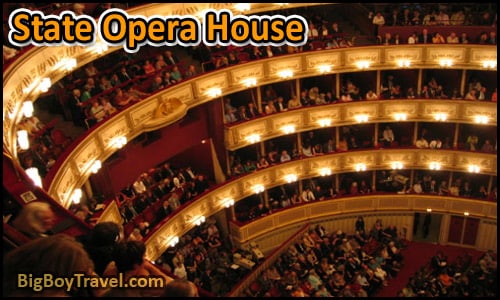
About The State Opera House : In a city famous for music and the arts, it is the grand Vienna State Opera House ( Staatsoper ), that definitely takes the prize. Opened in 1863, this gorgeous 1200 seat theater has housed some of Austria’s most famous classical musicians and still hosts over 300 performances a year. The beautiful theater and grand common areas make touring the Opera House amazing. If you are looking to catch a show, you can expect to choose from famous operas, ballets, and can even take part in large Viennese Balls each February.
This monument to music is the perfect place to start our free Vienna walking tour as the arts have been such an important part of the city’s culture and history. It was in Vienna where the Waltz was born and where Mozart wrote his famous opera The Marriage of Figaro. The building of the opera house was part of a larger protect in the mid-1800s where the Emperor replaced Vienna’s Medieval moated wall with grand buildings and a modern boulevard known as the Ringstrasse. Will will revisit the Ring Road at the end of this walking tour.
Guided Tours : 9€ for Adults; 4€ for kids; also includes the Opera Museum; 1-6 tours daily ( check website ). Tour is great and brings you to a lot of backstage areas. Live Performances : Tickets range from 16-215€, can be bought online , and go fast. Ticket Tip : If a show is sold out or if you just want a taste of a show without sitting through a 3-hour opera or ballet, they sell 567 standing room tickets the day of each performance, 160 of these tickets are right below the Emperor’s Box. Standing Room tickets are cheap, 2€ upstairs and 3.50€ downstairs, and allow you to easily leave when you’ve had your fill. These tickets go on sale 60 minutes before each show at the front door and 80 minutes before the show inside the side door at the Standing Room ( Stehplätze ) booth which always has a short line. Interactive 360 Degree Tour : ( 360 Degrees During a Viennese Ball ). Opera House Website : ( HERE ).
2. Castle Park ( Burggarten ):
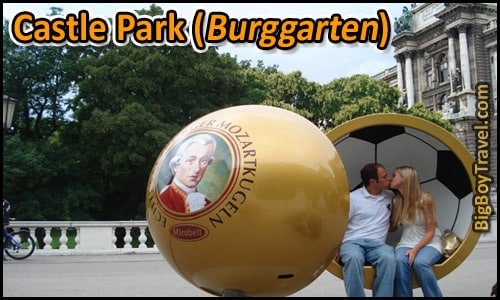
About Burggarten : Covering the entire backside of Hofburg Palace’s Neueburg wing is the large and peaceful Castle Park ( Burggarten ). From the 1200s through the 1500s, the Castle Park you see today part of a wide protective moat that circled Vienna’s Medieval city wall. It was these strong defenses that protected the city and stopped the Ottomans from taking over Europe in Siege of Vienna in 1529. After some further attacks in the mid-1600s, this Western section of the city wall was bumped outward to create a buffer zone for the nearby Hofburg Castle which also allowed the castle to gradually expand into a sprawling multi-wing palace.
By 1710, there was a vast private Royal park that started here and stretched a 1/2 mile to the Northwest along the inside of the expanded city wall. With the new found space in this huge Castle Park, the Habsburg rulers were able to build over their former private park, called the Paradise Royal Garden , to establish the Winter Riding School and National Library. We will visit both the riding school and library later on this free Vienna walking tour.
In 1806, Napoleon Bonaparte and his French forces heavily damaged the city wall and bastions near Castle Park before occupying the city, declaring an end to the Holy Roman Empire , and later marrying into the Habsburg family in 1810. A new curtain wall was added to repair the damage left by the French and Emperor Franz Joseph I got to work transforming this section of the park into a fenced-off private English Garden . During the park upgrades, around 1819-1820, Emperor Franz Joseph I had a statue of himself on a horse moved from the old Paradise Royal Garden to the pond in Castle Park. Cast in 1781, the statue is the oldest equestrian statue in Vienna and still a focal part of Castle Park.
Today the Castle Park has an awesome backdrop of the enormous Neueburg wing of Hofburg Palace ( built from 1881-1913 ), which was we will visit later on this free Vienna walking tour. The new building divided the Royal park in two separating the English Garden which forms today’s park from the rest of the grounds.
Just five years of Neueburg was finished, the monarchy fell in 1918 and the private Castle Park became a public park almost overnight. More statues were brought into Castle Park from around Vienna after WW2 including one of Hercules originally cast in 1770. Our favorite piece that was brought in is the white-wash Mozart statue which was carved in 1896 and previously sat in nearby Albertina Square. Make sure to take time to relax in the park just like the Viennese royals used to do.
3. Palm Tree House ( Palmenhaus ):
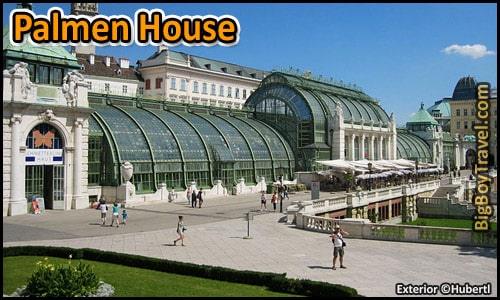
About The Palm House : While revamping his private Castle Park in 1823, Emperor Franz Joseph I also had a huge two-winged greenhouse built on the Northeastern end of the royal garden dubbed the Palmen House. This gigantic greenhouse was built right over the foundation of a section of Vienna’s Medieval city wall that dated back to the year 1200. The Palmen House was a huge luxury for the royal family as it was able to grow tons of tropical plants and palm trees even in the coldest Austrian days.
In 1902, the Palmen House was expanded to over 22,000 square feet and remolded in its current Art Nouveau-style . In modern times, the Palmen House has been turned into a really unique restaurant where you can eat under the palms trees even in the dead of Winter. Especially if you have kids with you, consider stopping at the tropical Butterfly House ( website ) which is attached to the North side of the restaurant.
Palmen House Restaurant Hours : Monday-Friday 10am-Midnight; Saturday 9am-Midnight; Sunday 9am-11pm. The outdoor terrace bar is open until 2am in Summer. Restaurant Website : ( here ). B utterfly House Cost : Adults 7€; kids 4€.
3. Albertina Museum :
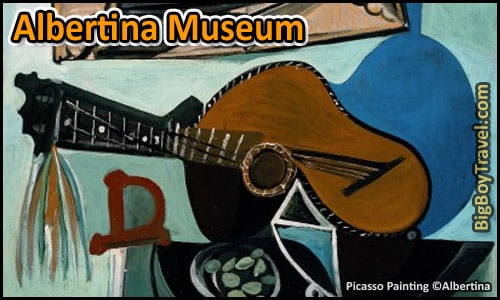
About The Albertina Museum : The Albertina Museum is a breath of fresh air house priceless art inside a stately villa. The most prized pieces are the works by Albrecht Dürer including the Young Hare from 1502 ( original is displayed twice every 5 years, but an exact copy is shown daily ). Other paintings & sketches include works by Monet, Picasso, Chagall, Klimt, Raphael, Warhol, and Rubens.
Like the Palmen House, the Albertina Museum was built over part of the early-Medieval wall section ( called the Augustine Bastion ) dating back to the 1200s. The property first served as the office for the Royal Court Building Authority before it was rebuilt as a mansion for Count Emanuel in 1744. This stately villa was later gifted to Duke Albert by Emperor Franz II in 1794. After moving in, the powerful Duke Albert started to display his private collection of works from old world master painters in the mansion which laid the groundwork for today’s museum. The works include the artists Da Vinci, Michelangelo, Dürer, Rembrandt, and Ruben.
Over the generations the Duke Albert’s family owned the villa, the back of it was expanded into parts of the neighboring Augustiner Monastery . The historic Augustiner Church was the only part of the block-long monastery complex ( built in 1327 ) which was spared from the expansion of the Albertina Mansion. The church is famous as the location of many of the Habsburg imperial weddings including that Marie Louise to Napoleon Bonaparte in 1810. The Augustiner Church also holds the hearts of the former Hapsburg rulers.
The most famous of the 20 staterooms added onto the villa are the ones built for Maria Christina ( 1858-1929 ), the only one of Marie Antoinette’s siblings who was allowed to marry for love. The opulent rooms are typically called the Spanish Apartments because of Maria Christina’s marriage to the Spanish King Alfonso XIII. Her sister Marie Antoinette even stayed in the apartments before being sent off to France for her arranged marriage with King Louis XVI. Our favorite of the staterooms is the Hall Of Muses which is ringed with Greek statues and lit with 5 crystal chandeliers holding 258 candles.
Make sure to check out the wonderful bronze statue of Duke Albert on the terrace near the museum entrance. At the street level below the statue, there is also a magnificent fountain depicting the river God Danuvius and the embodiment of Vindobona, Vienna’s name in Roman times.
Museum Cost : 16€ for Adults; 19-26 years old 11€; Children under 19 are free; guided tour 4€. Online Tickets : To skip the line and get a mobile-friendly ticket you can book HERE . Museum Hours : Daily from 10am-6pm; until 9pm on Wednesdays & Fridays; best after Noon. Museum Website : ( here ).
4. Sacher Café :
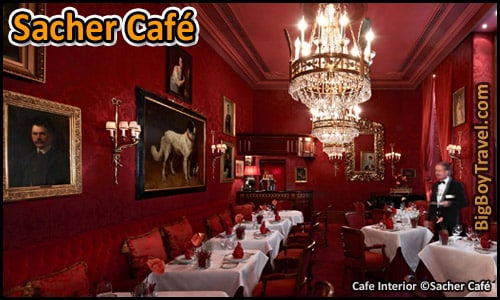
About Sacher Café : Sacher Café is known for having the best slice of chocolate cake you can find anywhere. Their world-famous cake , known as the Original Sacher-Torte, was the creation of chef Franz Sacher who was asked to make a dessert for a Hapsburg royal party in 1832 while only 16 years old. Word of the Sacher’s amazing cake spread and he quickly became a household name.
Forever known as the family of rich cake, Sacher’s son Ed opened the Sacher Hotel and Café in 1876 and spared no expensive decorating every elegant detail. When Ed died 16 years later, his wife Anna took over and pushed the property to gain global recognition as one of the best hotels , all while continuing to sell the famous cake of course.
The Gürtler family has been running the Sacher Hotel and Café since 1934 and it remains one of the very few privately owned five-star luxury hotels in the World. The Sacher Café has been the meeting point for famous figures from Gandhi, and Queen Elizabeth II to John F Kennedy. A visit to Sacher is truly a must while in Vienna and even if you are on a budget just 8€ can get you a really good coffee and an excellent slice of cake.
Inside the Sacher Hotel, there are three different colored fancy salons for dining in addition to the main cafe plus the 2-story Eck which views over the Opera House. If there are crowds hoarding the fancier dining area of the cafe consider buying your Sacher cake at the neighboring Sacher Stube Café which is run by the same family. If you are confused and which coffee goes best with the cake, the traditional drink in Vienna is hot black coffee with foamed milk and whipped cream.
Hours : Daily 8am-Midnight. Photos : ( Treat Photos via their Facebook Page ). Restaurant Website : HERE . Cafe Website : HERE .
6. Anti-War & Fascism Monument :
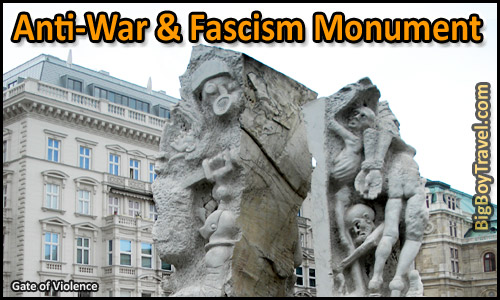
About The Monument : In the late-1800s a huge luxury apartment complex named Philipphof was built right in the middle of this large open courtyard overlooking Albertina Square. Previously the courtyard had been a Medieval pig market before being turned into the apartments in 1882. During the construction, they found even more history when they dug up an ancient Roman grave and a 21-foot section of Roman road.
Sadly in the height of WW2, hundreds of residents sought shelter in the basement of the Philipphof Apartments and were buried alive in an air raid on March 12th, 1945. The bombing was so heavy that most of the victims’ bodies couldn’t even be recovered from the rubble. With the memory of the war victims in mind, a series of statues were erected in 1988 on the site of the former apartment which now serves as the Anti-War and Fascism Monument.
The Anti-War Monument is primarily made up of four artistic pieces which highlight the violence and tragedy that Austrians faced in WWII while under Nazi rule. The most predominant part of the monument are the two large carved marble columns called the Gate of Violence which represent the victims of war and the concentration camps. The graphic images on the columns are actually carved into stone that came from Austria’s Mauthausen Concentration Camp. Another heartfelt piece is the bronze figure kneeling and covered in barbed wired while scrubbing the street which is meant to be a reminder of the humiliation many Jews went through before being more formerly persecuted. There is also a memorial for the people who died in an air raid of the Philipphof Apartments and the final section celebrates a free Austria after the end of Nazi rule.
In 2009, the open square was renamed Helmut Zilk-Platz after the Mayor of Vienna who pushed for the monument to be built in the 1980s. The gravity of a visit is definitely is worth a moment of silence and reflection to take it all in. Knowing the history behind what you are looking at makes the Anti-War & Fascism Monument one of the most moving stops on our free Vienna walking tour.
7. Imperial Crypt ( Kaisergruft ):
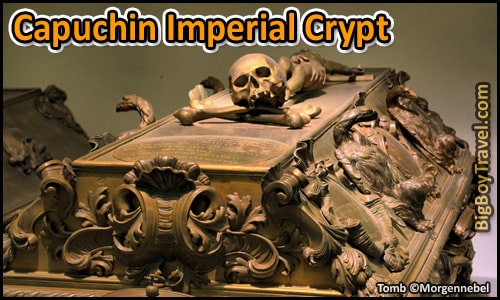
About The Imperial Crypt : The unique and slightly creepy Imperial Crypt below the Capuchin Church is a true must-see on our free Vienna walking tour. The church was part of the Capuchin Monastery, founded in 1617 by the Holy Roman Emperor Matthias’ wife Anna. Just one year later Anna died followed by her husband in 1619 which lead the way for their nephew Ferdinand II to take over as Holy Roman Emperor. In honor of his family, Ferdinand II started work on a royal crypt below the Capuchin Monastery in 1622 which took 11 years to finish because of delays from the 30 Years War.
The tombs of Emperor Matthias and Empress Anna were the first to be moved in the Imperial Crypt which has since been expanded eight times to hold elaborate tombs of some of Austria’s greatest leaders. In total there are bodies of 150 members of the Hapsburg royal family buried at under the Capuchin Church. Oddly it is really only the bodies in the tombs as the Habsburgs’ organs are not buried here . The royal guts are actually housed below Saint Stephen’s Cathedral and their hearts are in the Augustiner Church. While the Crypt has huge visual and photogenic appeal, it is also a very informative experience. The most visited tombs are those of Empress Maria Theresa and Emperor Franz Joseph.
In front of the Capuchin Church is New Market Square which served as one of the main markets in Roman times when this area of town was a civilian settlement just outside the walls of the Vindobona fort. The square was given a makeover as the new city of Vienna was laid out in the 1200s and became it a grain market. The beautiful fountain from the 1700s is called the Fountain of Providence ( Providentiabrunnen ). This is a replica as the original fountain was moved from here to Belvedere Palace because the central statue had a bare-chested lady on it. Many of the buildings surrounding the square were leveled by bombing in WW2.
Crypt Cost : 7.50€ for Adults or 4.50€ for kids. Visiting Hours : Daily from 10am-6pm ( last admission 5:30pm). Guide Tours : Wednesday-Saturday 2pm in German and 3:30pm in English for 3€ extra. Crypt Website : HERE .
8. Carinthia Road ( Kärntner Strasse ):
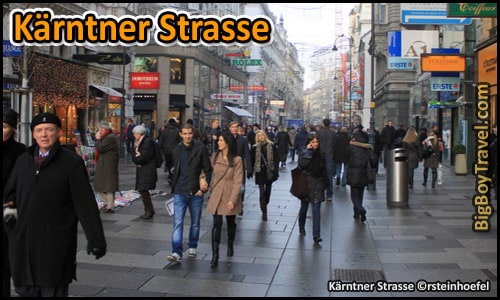
About Kärntner Strasse : Today the pedestrian-only Kärntner Strasse is one of Vienna’s most popular streets lined with great shops and places to eat. If you need to get any souvenirs for yourself or gifts while in Vienna then Kärntner Strasse is a perfect place to look. A stroll down the street offers excellent people watching, window shopping, and even your fix of American fast food, but we suggest sticking to the local cafes to get the true Viennese feel.
Back when Vienna was fortified military camp of Vindobona ( 97-433AD ), Kärntner Strasse cut right through the 24,000-person urban settlement surrounding the fort. Initially called the Strata Carinthianorum , it cut straight South from the fort’s Eastern gate and past the main civilian market. The name Kärntner Strasse comes because the road led to Austria’s Southernmost state of Carinthia ( Kärntner ) which sits on the modern Alpine border with both Italy and Slovenia.
Kärntner Strasse became more important after the 50,000-person regional Roman capital of Carnuntum just 30 miles East of town fell in 395. This caused the North-South trade route called the Amber Road ( Bernsteinstraße ) to be re-routed from Carnuntum right down the center of Vindobona. The route which started in Saint Petersberg, Russia on the Baltic Sea and transferred precious amber to Rome, Greece, and even Egypt in the South with access later to the port of Venice.
While many of the Roman camps never recovered after the Northern part of the Empire collapsed by 433AD, Vindobona was reborn as Vienna ( Wien ) in 881AD . The re-foritifcation and re-settlement of the town was largely thanks to its river access and ability to sustain itself with trade routes like Kärntner Strasse.
The road finally got its own gate into the city when the old Roman walls were expanded outward in 1257 to make way for a growing Vienna. Through Medieval times, Kärntner Strasse even had a drawbridge and bastion over the city’s moat. Over the centuries, modern-day Kärntner Strasse was re-revamped along with the town and has remained one of the busiest shopping streets in Vienna.
8. Staff In Iron Square ( Stock-im-Eisen Platz ):
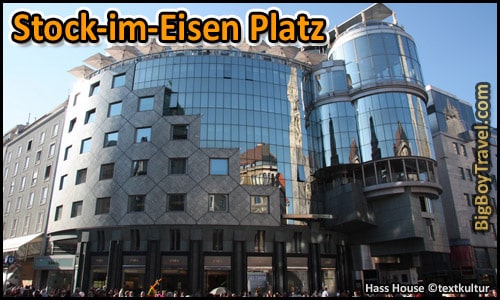
About Staff In Iron Square : As you reach the end of Kärntner Strasse, look immediately to your left and check out the Palais Equitable before getting distracted by any nearby sights. The humongous mansion was built for an American insurance company in 1891 in place of five Medieval buildings on what was once the small square called Staff In Iron Square ( Stock-im-Eisen Platz ). The square, which in ancient times was a Roman cemetery, was named after the historic nailing tree which sits encased in glass on the corner of the Palais Equitable.
The nailing tree ( nagelbaum ) grew nearby in the early 1400s and was used by travelers who pounded nails into it for good luck. The gesture was considered a sacrifice because in the Middle Ages iron nails were quite valuable. While the tree was cut down in 1440, the trunk continued to be used as a nailing tree, was put on display in 1548, and later iron banded by the former homeowner Hans Buettinger. As you inspect the Palais Equitable mansion, you’ll see reliefs on the doors showing the legend of the nailing tree.
In the 1900s, the North side of Staff In Iron Square was opened up to connect to Saint Stephen’s Square which we will visit next on this free Vienna walking tour. The focal point of this new construction is the very modern 8-story tall Haas House with flowing, curved glass walls. The building truly was meant to blend the old with the new as it sits right on the Southern corner of the former Roman camp Vindobona.
During the construction of the Haas House in 1990, it was very controversial that it was built anchored into some of the ancient Roman wall ruins. Make sure to get some photos of the Saint Stephen’s Church reflecting in the windows . If you are not too rushed and want the best view of Saint Stephen’s Church, head to the coffee house on the top floor of the Haas House for a unique perspective. The concept behind the design was to trace the Roman wall and provide a mirror image of Vienna’s largest church.
If you have an extra minute, make sure to go down into the subway station to see the underground Saint Virgil’s Chapel ( Virgilkapelle ) which was unearthed 40 feet below the ground in 1973. The old world chapel was carved out below the former Roman graveyard in 1220 as a private place for the Vienna’s wealthy residents to worship. Greek crosses, which can still be seen on the stone walls today were painted in 1246. In 1338 the funeral Chapel of Saint Mary Magdalene was built above the Saint Virgil’s which then became a bone house. A faint an outline of the former Saint Mary’s Chapel ( burned down in 1782 ) can be seen in the pavement as you approach Saint Stephen’s Square.
10. Saint Stephen’s Church ( Stephansdom ):
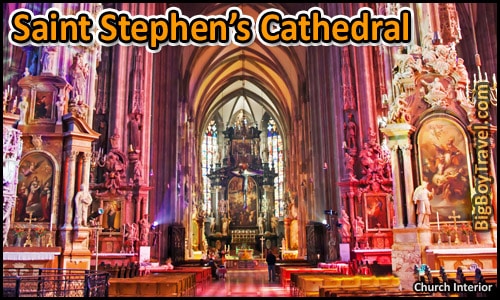
About Saint Stephen’s Church : The massive Gothic-style Saint Stephen’s Cathedral is the focal point and geographic center that modern Vienna orbits around. Saint Stephen’s started as a small parish in 1137 , in a large Roman cemetery in the former civilian area just outside of the walls of Vindobona. While Saint Stephen’s Chapel wasn’t finished until 1160, it was dedicated early in 1147 in the presence of King Otto II who was heading out to join the 2nd Crusade.
From 1230 to 1245, the chapel was completely redone as a larger Romanesque church with an impressive door and towers. Unfortunately, the Romanesque church burned down in 1258, but the front door and towers were saved and worked into the facade of the rebuilt church which was completed in 1263 over the ruins.
Looking at the front of Saint Peter’s today, you can still see the outline of the original Romanesque church towers. Working their way about halfway up today twin peaks you can see the change in the stone as they were extended upward in the rebuild and named the Roman Towers ( Heidentürme ) . The 213-foot-tall towers got their name because they were built using pieces of the former wall of the heathen ( heiden ) Roman military camp called Vindobona. Keep in mind that during the time of the Roman settlement here, the Empire did turn Christian under Constantine so calling them heathen was more of the Medieval Duke’s way of appearing greater than their predecessors.
Saint Stephen’s finally got official Cathedral status shortly after the construction began on the Gothic-style Albertine Choir on the North end of the Church in 1359. The large choir, with three naves, has fantastic Medieval stain glass windows which are the only ones in the church to survive WW2. Instead of merely remodeling the rest of Saint Stephen’s original Romanesque interior to match the Gothic choir, they built a new church around it instead. New sidewalls were added outside of Saint Stephen’s, with a vaulted wooden roof hovering 125 over the floor. After the new walls and roof completely encapsulated Saint Stephen’s Church, the old side walls were simply removed.
By far the most iconic thing to come out of the Gothic-remodel is the mega-sized South Tower called Old Steve ( Alter Steffl ) . At 466 feet tall, the gigantic tower dominates Old Town Vienna from every angle. We highly suggest taking the tiring 363 steps up to the top for the best views of Vienna. If you aren’t up for the hike up the Old Steve, consider taking the elevator up the North Tower ( Nordturm ) instead. The stumpy North Tower was supposed to be a complete match to Old Steve, but construction stopped in 1511 freezing it at 231 feet tall. While excavating for North Tower in 1443, they found a thighbone of a mastodon and placed it above the church’s front door nicknaming it the Giant’s Door ( Riesentor ) .
The North Tower is best known for its large bell, appropriately named Boomer Bell ( Pummerin ) , which famously rings each year at midnight on New Year’s Eve. The was cast out of Turkish cannons after the Siege of 1683, is over 20 tons in weight and 10 feet in diameter. It is considered the 2nd largest free-swinging bell in Europe. From either side tower, you will also get a great view of the brightly colored ceramic tiled roof which replaced the wooden one burn in WW2. The patterns on the roof include a double-headed eagle which is the crest of Vienna.
As you wander around Saint Stephen’s Cathedral there are a lot of exciting details worth noting. We really love the centrally located sandstone pulpit carved in 1510. It shows faces of the four fathers of the Latin Church ( Ambrose, Jerome, Gregory and Augustine ) as well as the artist who carved it peaking through a window near the stairs. Below the Medieval glass windows of the nave is the baroque New City Altar ( Neustädter Altar ) carved in 1447. Near the altar is the tomb of Emperor Frederick III who is one of the only Habsburgs to be buried outside of the Imperial Crypt. Below Saint Stephen’s Cathedral, you can tour the catacombs where the guts of the Habsburgs rulers are stored along with the bodies of Vienna’s cardinals and archbishops. The catacombs also have stacks of bones as bodies were tossed down here during a plague in the 1700s when the cemetery surrounding Saint Stephen’s Church was closed.
Around the Saint Stephen’s exterior, you can see the stark color difference where coal pollution darkened the church’s white limestone and where it has been cleaned. You will also see dozens of headstones from former church cemetery’s worked into the building’s facade. Speaking of death, Mozart had his funeral at Saint Stephen’s in 1791. The famous composer not only spent time working at the church, but was also married here in 1782.
Cathedral Hours : Monday-Saturday 9-11am & 1-4:30pm ( restricted access starting at 6am ); Sundays not until 1pm; Tower Climbs Daily 9am-5:30pm. Cost : Cathedral entrance is free but restricted unless you pay 6€ for the audio guide; North Tower 6€; South Tower 5€; Treasury 5.50€, Catacombs 6€ ( takes 30 minutes ). Discounted Online Tickets : You can skip the lines, save money, and get a mobile combo ticket for the South Tower, North Tower, Cathedral tour, Catacombs Tour, Treasury Tour, and audio guide HERE . Religious Service : Sundays & Holidays at 10:15am, 9:30am in July & August. Tower Access : South Tower via 363 steps or North Tower with elevator. Cathedral Website : ( here ).
11. Mozart’s Vienna Apartments ( Mozarthaus ):
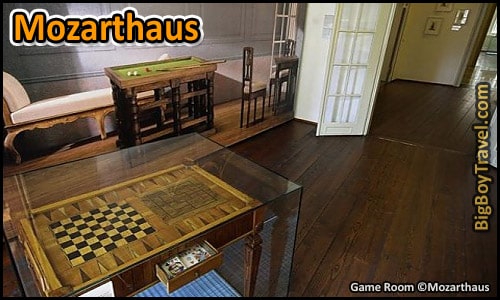
About Mozart’s Apartments : Most of Mozart’s life was spent in his hometown of Salzburg, but he also had close ties to Vienna. It started when Empress Maria Teresa brought the young prodigy in to play a concert at Schönbrunn Palace as a child and continued when Mozart moved here in 1781 to get out from under the thumb of Salzburg’s archbishop.
Mozart was taken in by Vienna’s Archbishop Colloredo and lived his monastery for six weeks in the year 1781 from March 16th until May 2nd. The monastery was built in 1375 for the Teutonic Knights, and its intimate Sala Terrena concert hall where Mozart performed still hold live chamber music performance you can attend. Sala Terrena is Vienna’s oldest concert hall and was painted the Venetian late Renaissance style in the mid-1700s making it a fantastic place to hear a string quartet.
After leaving the monastery in 1781, Mozart moved in on the Graben near Saint Peter’s Square with the Weber who was in Vienna from Mannheim, Germany. Mozart had met the family in German in 1777 where he tried to court the daughter Aloisa, but ended up marrying their younger musician daughter Constanze in 1782 at Saint Stephan’s Cathedral. The couple moved around before settling on a lavish apartment behind the cathedral known today at the Mozarthaus Museum where they lived from 1784-1787.
The family’s apartment only had 4 main rooms, but with its city center location and rich details cost 450 florins a year to rent which was more than Mozarts dad’s annual salary. Although Mozart was horrible at saving money, he was making a lot of it teaching piano to young aristocrats mixed in with significant commission works. To the sculptured ceiling in the Camesina room. The Mozarthaus Museum is quite popular with theatergoers as the apartment is where Mozart wrote his famous opera The Marriage of Figaro which premiered in Vienna.
Most of the items on display at the Mozarthaus Museum today are from the time of Mozart and not actually his stuff , but it all helps to give a peek into his time here. Tours start on the 3rd floor of the building covering details of Mozart’s time in Vienna. The displays focus on where Mozart lived and performed, who his friends and supporters were, his relationship to the Freemasons, his passion for games and much more. The presentation on the 2nd-floor deals with Mozart’s operatic famous works he wrote while living here, and the apartment on the 1st floor focuses more on Mozart and his family. The basement also has a vaulted ceiling event space that often holds piano concerts.
Mozarthaus Cost : 11€ for Adults, 4.5€ for Children, also has a family rate of 24€ ( up to 2 Adults, 3 kids ). Discounted Tickets : You can save money and get a free audio guide by pre-booking HERE . Mozarthaus H ours : Daily from 10am-7pm; last entrance 6:30pm; least crowded 10am-Noon. Mozarthaus Website : ( here ). Sala Terrena Concerts : 90-minute concerts are on Thurs, Fri, & Sun at 7:30pm and Sat at 6pm. Sala Terrena Website : ( here ).
12. Graben & Plague Monument ( Pestsäule ):
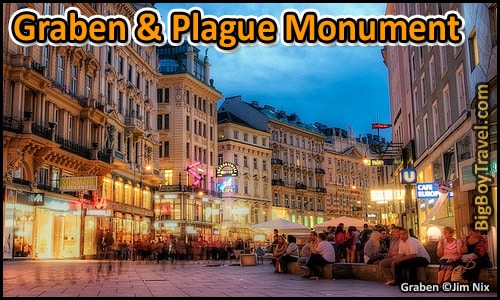
About The Graben : The Graben ( meaning ditch ), was once used as a dry moat by the Romans along the Southern wall of their ancient military camp Vindobona ( 97-433AD ) which pre-dates Vienna. With Vienna’s population growing the graben was filled in and the walls were expanded outward in the 1200s. A King’s ransom largely funded this massive project, and it’s from a tail you may have heard of before.
After fighting together in the 3rd Crusade, Duke Leopold V of Austria captured King Richard I of England ( also known as Lionheart ) over a dispute. King Richard ( of Robin Hood fame ) was held as a prisoner for 14 months from 1192-1194 while his brother Prince John sat on the throne. It’s said that Pince John offered to pay the Duke to keep his brother longer so he could stay on the throne. King Richard, I was finally released after a colossal ransom to the Holy Roman Emperor, of which Austria got 35 metric tons of silver ( worth over $15 million today ).
For the next 60 years, this ransom money was used on projects in Vienna from establishing the Austrian Mint, filling the Graben, building churches, and expanding the city wall. With the wall expansion completed by 1257, the Graben quickly became a market and busy shopping street. The first of two elegant fountains along the Graben is dedicated to Duke Leopold V for getting the money to start the project.
The half-timber Medieval homes first lined the boulevard are now gone, can see the wealth the shopping has generated by the elegant facades of massive buildings that line the Graben. We love walking here as the Graben became Vienna’s first pedestrian-only area in 1974 and it feels built for people watching. If you happen to be in Vienna during Advent ( late-November through Christmas ), you need to put a night-time stop at the Graben on the top of your list as its endless strings of holiday lighting are magical.
Americans visitors often overlook the impact of the epidemics in Europe during the Middle Ages making the Plague Monument ( Pestsäule ) in the center of the Graben an important attraction. The 69-foot-tall column was built in 1693 to honor the 1/3 of Vienna’s population who died in the Plague of 1679 and pays thanks to God for the ones who survived. The golden-capped Baroque column replaced a previous column dedicated to the Holy Brotherhood. It was the Brotherhood of the Holy Trinity who was among the first groups in Europe to use science to stem the plague in a time where religion and superstition trumped all.
Photos : ( Night Time During Advent ).
13. Saint Peter’s Church ( Peterkirche ):
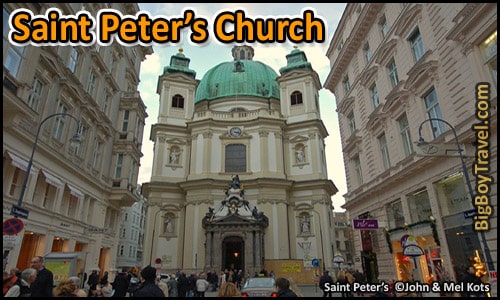
About Saint Peter’s Church : As you turn the corner off the Graben down Jungferngässchen Alley you catch your first glimpse of the green-domed Saint Peter’s Church. Entering the alley, you are also crossing what was once the Southern wall of the Roman fort Vindobona ( 97-433AD ). Local folklore says a larger Romanesque-style church was built here by Emperor Charlemagne between 792-800AD while the former camp was being re-fortified.
While Charlemagne church story may be true, records show that the first church here named Saint Peter’s was finished in 1137 before the original city walls were expanded outward. The church which was later run by the Scottish Monastery which burned down in the late-1600s giving way to the Baroque masterpiece you see today.
Completed in 1732, today’s Saint Peter’s Church is one of the hidden gems on this free Vienna walking tour. We are amazed the builders were able to fit such a large structure tightly tucked into a small square . When you get inside the church, you quickly forget how small the plot of land is that it sits on. This is because the builders used an open layout and unique dome to make Saint Peter’s Church feel huge. Unlike most churches, Saint Peter’s is actually oval shaped instead of round to take maximizing the space to a whole new level.
Most people walk by taking a couple of pictures of the exterior and leave, don’t be one of those people. Take a couple of minutes to step inside, inspect the beautiful marble interior, and see if you can make out the dome’s oval shape.
Hours : Monday-Friday 7am-8pm; Weekends 9am-9pm. Cost : Free. Tours : Daily 9-10am & 1-3pm. Interactive 360 Degree Tour : ( Interior ). Church Website : ( here ).
14. Vindobona & In Court Square ( Am Hof ):
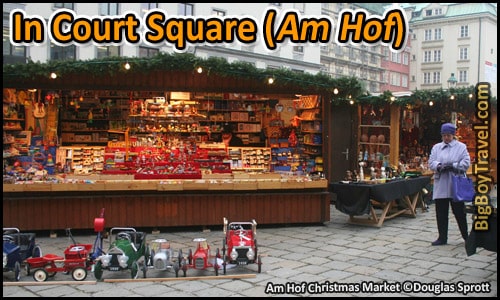
About Vindobona & Am Hof : Lightly settled by the Celts in 500BC, the groundwork for modern-day Vienna was laid out from 15-97AD as a fortified Roman camp named Vindobona ( meaning White Village ). Outlined on our free Vienna walking tour map, the walled Vindobona fort marked the edge of the Roman Empire at the time and was used to help fight off Germanic forces North of the Danube River.
While the nearby regional Roman capital of Carnuntum was much more significant with over 50,000 residents, at its peak Vindobona was home to 6,000 soldiers inside its walls and another 24,000 residence in the surrounding urban area. The most famous moment in the history of the camp was when Roman Emperor Marcus Aurelius died here in 180AD. After the Northen Roman Empire fell in 433AD, the remaining citizens around Vindobona moved inside the walls of the abandoned camp, and the population drastically declined.
The former camp was re-fortified in the 800s including a small Berghof Restsiedlung Castle to help defend against Magyar ( Hungarian ) armies. The castle was built over the Roman thermal baths between the Hoyer Market and Saint Ruperts Church. Shortly after the refortification, Vindobona took the name Vienna ( Wein ) in 881 after the Vienna River ( Weinfluss ) which is Celtic for Wood Creek .
In 1156, Heinrich II of Babenberg was forced by the Holy Roman Emperor to give up his title Duke of Bavaria to Henry the Lion and was named the 1st Duke of Austria by the in return. With a fresh canvass at his disposal, Heinrich II moved to Vienna and built Castle Babenbergerpfalz inside the old Roman wall. The new castle sat right on the foundations of Vindobona’s former barracks and armory in the former fort’s Southwest corner ( where today’s Am Hof Church and Park Hyatt Hotel are ). The large square next to the castle became the city’s 1st established Royal Court ( Am Hof ) . So if you stay in the Park Hyatt ( website ) today, you are not only staying at one of the best hotels in town, but also over the former castle.
The Duke really wanted to impress his wife Theodora Comnena, who was a Byzantine princess, with is new city plans. He used is former home, and capital of Bavaria at the time, Regensburg, Germany as the model to layout Vienna. Under Heinrich II’s rule, Vienna quickly became the 2nd largest city in the Holy Roman Empire behind Cologne, Germany.
Five years after the last Duke in the Babenberg family died in 1246, Ottokar Duke of Moravia ( King of Bohemia ) was elected Duke of Austria and significantly expanded the Kingdom to stretch all the way to the Adriatic Sea. Ottokar also started to expanded Vienna’s city walls outward and built a new four-towered royal castle called Hofburg on the Southern edge of town ( see photo ).
In 1273, Rudolf I of Hapsburg ( King of Germany ) was elected the new Duke of Austria, but Ottokar wouldn’t give up his title which led to his death on the battlefield. Rudolf’s success led to 645 years of Hapsburg rule over Austria including over 300 years as Holy Roman Emperors ( 1483–1806 ). While the royal court was officially moved to Hofburg Castle, Am Hof Square at Castle Babenbergerpfalz continued to be used for jousting tournaments and a market.
While most of the old Castle Babenbergerpfalz was removed, part was rebuilt as the Gothic-style Am Hof Church in 1386. The church was given its current white Baroque facade in 1662, and the Mariensaeule ( Marian Column ) was added to the center of the square. The column, finished in 1667, was commissioned by the Holy Roman Emperor Ferdinand III to thank the Virgin Mary for repelling the Swedish forces during the 30 Years’ War. In 1806, having defeated the Austrian army, Napoleon announced the end of the Holy Roman Empire from the balcony of the Am Hof Church. This move split the former territories up and established the Austrian Empire.
Am Hof Square got a rise in pop culture thanks to the hit 1949 movie The 3rd Man . Many scenes from the famous film take place here from Anna’s door to Orson Welles’ character Harry Lime casting a long shadow in the alleyway North of the Church. In the cellar of the Am Hof Square’s Fire Brigade Building, you can still find the remains of a main brick drain from the ancient Roman sewer system beneath Vienna.
For more Vindobona sites check out the Roman Museum ( website ) under Hoyer Market. Located on one of Vienna’s oldest market squares, the museum has a great collection of authentic Roman era artifacts. The best objects are the intact sections of soldier homes and underground heating they found below the square. We also like stopping Saint Rupert’s Church which is Vienna’s oldest church dating back to 740 and sits near a maze of Medieval streets.
15. Kohlmarkt & Demel Café :
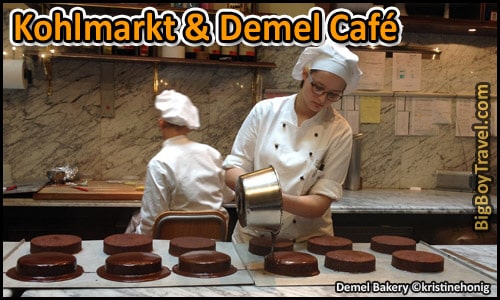
About Kohlmarkt : The prestigious Coal Market ( Kohlmarkt ) shopping lane is home to Vienna’s most luxurious stores . From Tiffany’s to Gucci and Louis Vuitton you’ll find a little bit of everything for today’s high-end buyers. In Roman times, this road led to the main Southern gate tower ( Peilertor ) of the walled fort called Vindobona ( 97-433AD ) which pre-dates Vienna. It was an important road as two blocks outside the walls it intersected with a civilian bypass of the Lime Road ( Limesstrasse ) trade route around the fort before continuing all the way through Linz to Salzburg ( then called Juvavum ).
When the Roman wall was extended outward in 1257, the lane remained vital as it connected the new Royal Castle ( Hofburg ) to the heart of Vienna. While the name Coal Market came from the coal dealers who once set up shop here, it quickly became a prestigious shopping area. Kohlmarkt was soon home to the shops of various jewelers appointed by the Royal Family and gained the nickname the Golden U .
During the 1700s, the street blossomed into a well-rounded, high-end shopping street. Even the original city gate tower, called the Direction Finder Tower ( Peilertor ), also remained an essential feature of Kohlmarkt. Through Medieval times the tower ( rebuilt in 1511 ) served as a watchtower and jail until it was removed for traffic concerns in 1867.
Today the lane is a real treat, especially during Advent when hanging lights give Kohlmarkt a beautifully lit temporary ceiling. While you window shop along Kohlmarkt, the one place you have to make sure to stop at is the Demel Café & Bakery . Dessert artist and baker Ludwig Dehne moved to Vienna from Wuerttemberg in 1786 and quickly impressed the Emperor with his skills. In the bakery’s early days, all the ladies of importance in Vienna came to the cafe to drink a cup of hot chocolate on the first cold day of the year.
Ludwig’s cafe business did so well that it gained the esteemed prefix K. u. K., or König und Kaiser , meaning “good enough for the king”. With Vienna being a trend-setting cafe town, Ludwig’s bakery became a favorite meeting point of the aristocracy as well as of the bourgeoisie. In 1857, Ludwig son August sold the shop to his first assistant Christoph Demel giving the cafe its current name. Even though it is a fancy place, Demel offers a 10€ cake and coffee deal, along with their other amazing chocolates and desserts to make your mouth water.
Demel Hours : Daily 9am-7pm. Demel Website : ( here ).
16. Michael’s Square ( Michaelerplatz ):
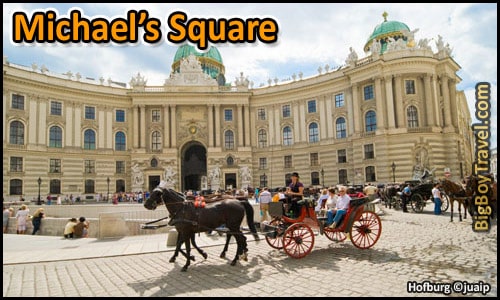
About Michael’s Square : Michael’s Square is dominated by the Baroque facade of Hofburg Palace’s Saint Michael Wing . This huge building was completed in 1889 in place of the old Royal Theater ( Burgtheater ). The former theater had opened here in 1741 inside an unused Royal banquet hall and was where many famous musical premieres took place. These premieres included Mozart’s Marriage of Figaro in 1786 and Beethoven’s 1st Symphony in 1800. While the first sections of the Royal Castle ( Hofburg ) were built near the Square in the mid-1200s, it’s been a critical intersection for nearly 2,000 years .
In Roman times, a civilian bypass of the Limes Road ( Norica Limes ) around the legion fort Vindobona ( early day Vienna ) met the main road into the fort’s Southern gate at Michael’s Square. The intersection also connected to a secondary route to Linz and Salzburg, but the diagonal bypass off the Limes Road ( seen as Herrengasse Street on modern maps ) was the big driver of traffic. The Limes Road essentially marked the Northern border of the Roman Empire while linking the 30 main legion camps along the Rhine and Danube Rivers from the North Sea all the way to the Black Sea.
At the crossroads of Michael’s Square stood a large guarded Roman Legion outpost ( Canabae Legionis ) to help protect the South side of the fort, its 6000 soldiers, and the 24,000 area civilians who lived outside of Vindobona’s walls. Eventually, the Limes Road broke down from hostile invasions ( Huns & Germanic Goths ) and most of the Northern Roman Empire collapsed by 433AD. Vindobona was largely abandoned until it was re-fortified as Vienna in 881AD, but luckily remains from its Roman roots are still easily found.
Ruins of the Roman Legion outpost at Michael’s Square were excavated in 1990, unearthing an entire neighborhood of Roman building foundations and ancient sewers. In addition to the guard houses, the outpost buildings were believed to have included shops, an inn guesthouse, and a brothel. Further excavations around Michaelerplatz have shown that the Romans also had created a long aqueduct to get water from the surrounding hills as well as several canals dug all the way to the Danube River.
The Roman Legion outpost was essentially like a small suburb , although it wasn’t given a town charter. The civilian settlement spread out many blocks from Michael’s Square and foundations of half-timber homes have been found in the courtyard of the Globe Museum ( Herrengasse #9 ), Porcia Mansion ( Herrengasse #9 ), and the Harrach Mansion ( Freyung #3 ). You can see the extent of the civilian settlement centered on Michael’s Square to the South of the square Vindobona fort here .
Before leaving the square, make sure to check out Saint Micheal’s Church which it is named after. First completed as a small Romanesque chapel from 1221-1252, it was rebuilt in 1792 as you see it today. The church is best known for its captivating crypt with the bodies of 4,000 wealthy residents who are buried here with many of them mummified or with open caskets. The crypt is very interesting, but is one of the most overlooked tourist spots on this free Vienna walking tour. Investigating the open ruins and sights around Michael’s Square is one of the best windows into Vienna’s Roman past.
17. Spanish Winter Riding School :
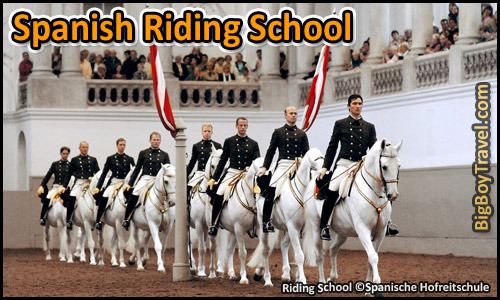
About Spanish Winter Riding School : The Spanish Riding School has been operating in Vienna since 1565 when it was a wooden stable in nearby Josefsplatz Square making it the oldest riding school in the World . The beautiful Spanish Winter Riding School building you see today was built into Hofburg Palace in 1735 in place of the former Paradise Garden.
This historic riding school gets its name from the stars of the show, the delightful white Lipizzaner horses from Spain. Getting accepted into the Spanish Riding School has always been a very prestigious thing. In its early days, the riding school was limited to young aristocrats and royals who used it to practice jousting and horse dancing called dressage. The horse dance training helped the riders the gain agility and control needed military campaigns. Outside of occasional public festivals, watching the horse dancing practices were reserved for the Royal family and guests of the court until the monarchy fell in 1918 which opened the shows up to the public.
Tickets for the horse dancing shows can be hard to come by so make sure to book ahead if possible. Even if you can’t make a dressage show, consider one of the school’s architectural tours that brings you through every nook and cranny of the building including the rafters. In addition to the horse ballet shows, the training space also hosts a series of elegant Viennese Balls throughout the year.
Across the street from the Winter Riding School is the Renaissance-style Royal Horse Stables ( Stallburg ) . The stables were first built from 1559 to 1569 as a mansion for crown prince Maximilian II by his dad Emperor Ferdinand I. Folklore says that the Emperor wanted his son under a different roof as they had differing religious views. The mansion later housed part of the royal art collection which helped to launch Vienna’s Art History Museum. When the new Winter Riding School opened in 1735, the mansion was turned into the official Royal Horse Stables and is now an active museum.
Ticket Office Hours : Tuesday-Sunday 9am-4pm; on Fridays when there is a performance they are open until 7pm. Morning Exercise : Most weeks Tuesday-Friday from 10am-Noon you can watch Morning practice to music for 15€ which is lighter on the jumping. Check the schedule here as some months have training every day. You book at the box office each morning. Main Performances : The full dressage show performances typically happen on Saturday and Sundays at 11am and can sell out far in advance. Standing tickets room start out at 25€ and go up to 135€ for the lower level seats. You can book online here or at the box office. Please note that from late-June through early-August they typically don’t run the full show, but will have practice. Guided Tours : Most afternoons they have 2-5 time slots for 50-minute guided tours of the grounds and stable for 18€ ( kids half off ) with the most time slots on Mondays while the horse training is off. You can book at the box office each morning. Riding School Website : ( Here ).
18. Joseph’s Square ( Josefsplatz ):
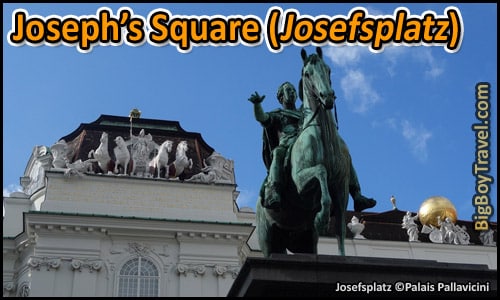
About Joseph’s Square : Before checking out the beautiful National Library, it is essential to inspect the often overlooked Joseph Square ( Josefzplatz ). Today the main feature of the square is the giant equestrian statue from 1795 of Emperor Joseph II in Roman clothing riding a horse.
The equestrian statue is actually a take on an ancient statue of Roman Empire Marcus Aurelius which sits on Capitoline Hill in Rome, Italy. The connection is important both because Marcus Aurelius died in the Roman camp Vindonba ( early day Vienna ) in 180 AD and the Habsburgs always claimed to have a bloodline connection to the Roman leaders. This equestrian statue is also fitting as Joseph Square was once the home to the original Spanish Riding School back when it was just a small wooden structure.
As you circle the square, there are a couple of old mansions that are worth mentioning. The 1st is the beautiful Pálffy Mansion ( website ) which served as a law office in the 1300s, was rebuilt as the home of a banker in the 1600s, and given a new facade after damage from WW2. Mozart performed at Pálffy Mansion as a child and did screenings of this opera The Marriage of Figaro with a small audience before premiering it at the Royal Theater that once sat a block away at Michaelplatz. Every night at 8pm ( except Wednesdays ) you can get tickets for the Vienna Walzer Orchestra which performs for small crowds just like Mozart once did here.
Next door to Pálffy Mansion is the impressive Pallavicini Mansion ( website ) which was once the site of the Queens Monastery ( 1581-1782 ). Unlike Palffy, this mansion was largely untouched by WW2 and serves as a time capsule for Viennese life in the late 1840s.
On the South side of the Joseph’s Square is the former Augustiner Monastery Complex ( built in 1327 ), which still has some of its original inner courtyards and main chapel. The monks had been operating in Vienna since 1260, and Pope John XXII directly approved the building of this complex. The small Loreto Chapel next to the main altar holds the hearts of various Habsburg rulers. Earlier in this Vienna walking tour, we saw the royal bodies in the Imperial Crypt and their guts in Saint Stephen’s Cathedral. The church probably the most famous as the place of many Habsburg imperial weddings including that of Marie Louise to Napoleon Bonaparte in 1810.
19. Austrian National Library :
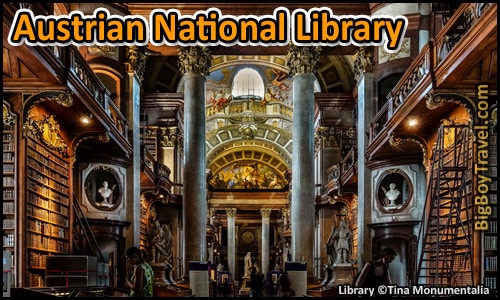
About The Austrian National Library : Built by Emperor Charles and Empress Maria Theresa from 1720-23, the Austrian National Library remains one of the most beautiful libraries in the world to this day. It is easy to find the entrance as the building is capped by a large golden globe supported by a statue of the Greek God Atlas. A walk through the Baroque State Hall is bound to leave any visitor with a sense of wonder.
The library’s marble accents are fantastic and the ceiling paintings are among some of the best for any building of its era. The paintings are so detailed that it’s no wonder they took an extra 7 years to complete after the library was open. The scenes show the virtues of the Hapsburg rulers as well as depictions of their territories.
The Habsburg Dynasty was a dominant one who had already had a private library collection started as early as the 1300s. This meant that the new library was able to be filled with over 400 years of treasures the day it opened. Mix in an over 300-year span where the Hapsburgs served as Holy Roman Emperors ( 1483–1806 ), you have the makings of one of the best book collections in the world . Construction plans even had to be expanded mid-build in the 1700s as the family’s collection continued to grow.
Two of the most popular exhibits run by the library are the impressive Papyrus and Globe Museums. The Papyrus Museum is best accessed through the reading rooms entrance of Heldenplatz ( Stop 21 ) while the Globe Museum is just down the street ( Herrengasse Avenue #9 ).
Library Hours : Daily 10am-6pm; Open Thursdays until 9pm. Cost : 7€ for State Hall; Add for 4€ the Papyrus and Globe Museums; Discounts for kid & families. Audio guide 5€ for 2 people. Library Website : Here .
20. Hofburg Castle’s Swiss Court ( Schweizerhof ):
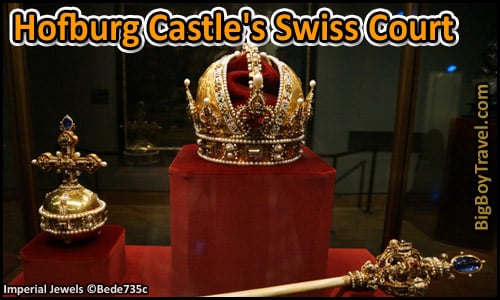
About The Swiss Court : This was the original portion of today’s Hofburg Palace ( or Imperial Castle ), built from 1220 to 1278 as a square Gothic castle with corner towers. The most construction happened along the expanded city walls under Ottokar II who became the Duke of Austria in 1251 and also soon became the King of Bohemia ( 1253-1278 ). After failing to win the Imperial crown numerous times and raising arms about it, Ottokar II was crushed in battle in 1278 and his castle was taken by the Habsburg who ruled Austria for the next 750 years ( 1278-1918 ).
Only fragments of the original castle remain today as it was given a Renaissance makeover in the 1400s. This project included a complete rebuild of the Palace Chapel ( Burgkapelle ) in 1449. A beautiful wooden statue of the Virgin Mary near the altar was carved in 1410 and is quite stunning. The royal chapel was first established in 1296 ( remodeled again in the 1700s ) and is famous for the angelic Vienna Boys Choir ( website ) who have been signing High Mass since 1498. They are one tour in July & August so if you miss out on the Boys Choir, the nearby Augustiner Church ( built in 1327 ) also has music at their 11am religious services.
In 1745, the original castle got another facelift during an expansion of the Palace, and the central courtyard was renamed the Swiss Court ( Schweizerhof ) after the guards who protected the Royal family. This substantial makeover also saw the removal of the corner towers and the castle’s drawbridge which once led to the preserved red-black Swiss Gate ( Schweizertor ) from 1552. The impressive gate displays the Holy Roman Empire’s Imperial Coat of Arms in the variation of the Order of the Golden Fleece which is a secret Medieval fraternity established in 1430. On the ceiling inside the Swiss Gate are murals showing the titles and lands ruled by Emperor Ferdinand I.
The core of the former castle now houses the Royal Treasury in over 21 Medieval rooms. While touring the Treasury, you will see the jewels of the Holy Roman Empire, including the Imperial Crown and the Holy Lance, the Crown of Emperor Rudolf II, and gems including one of the world’s largest emeralds. You will also see a ton of Holy Relics in the Treasury as the Habsburgs had become obsessed with collecting them as a status symbol. There are items from the Order of the Golden Fleece, and Counter-reformation among other secular treasures. Our favorite piece is the giant narwhal tooth from the 1500s which Medieval times was believed to be a unicorn horn.
Hofburg Treasury Hours : Wednesday-Monday 9am-530pm; open until 6pm in July and August; Closed Tuesdays. Admission Cost : 11.50€ for Adults; 10.5€ for Kids; which includes an audio guide. Royal Treasury Website : ( HERE ). Imperial Chapel Hours : Chapel is available for Free Mondays & Tuesdays 10am-2pm & Friday 11am-1pm. Vienna Boys Choir Shows : From September through June you buy a ticket can hear the Boys Choir sign in the chapel most Sundays at 9:15am. Vienna Boys Choir Tickets : You can buy tickets online here or on Fridays in person. Tickets are 5-29€ plus there is free stand room only tickets available for the first 60 people in line. Vienna Boys Choir Secret : You only hear and don’t see the Boys Choir with your ticket, but you can watch it on a screen for FREE in the small lobby to the right of the Chapel entrance. Imperial Chapel Website : ( HERE ).
21. Hofburg Imperial Apartments :
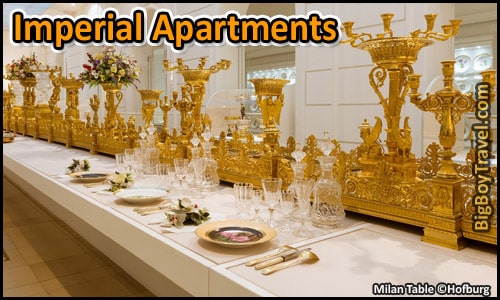
About The Imperial Apartments : The Imperial Apartments are our favorite part of the Hofburg Palace as they were the residential and state rooms used by Emperor Franz Joseph I and his wife Elizabeth , known as Sisi. The apartments are filled with over 165,000 pieces of original furniture from the Hapsburg Dynasty spanning over 300 years. There is also a section for the over-the-top Imperial furniture and a small museum dedicated to Sisi which includes many of her preserved dresses.
If you think the apartments and decor are fancy, just wait until you check out the Royal Sliver Collection ( website ). It seems like there is an endless amount of wealth on display, but they actually only display about 7,000 of the Habsburgs over 150,000 silver and gold items at a time. Our favorite part of the collection is the golden centerpiece spanning the entire length of the 90-foot-long Milan Table . The amazing work was commissioned for the coronation of Emperor Ferdinand in 1838.
Hofburg Palace Hours : Daily 9am-530pm; open until 6pm in July and August. Admission Cost : 15€ for Adults; 9€ for Kids; which includes an audio guide. Guided Tours : A guided tour is required to see the Imperial Apartments and Sisi Museum. They last for 55 minutes, leave daily at 2pm and adds only 2€ to admission cost. Combined Sisi Ticket : The Sisi ticket ( 34€ for Adults; 21€ for Kids ) is the best deal as it includes Schönbrunn Palace, Imperial Furniture Collection, Hofburg with the Imperial Apartments, Sisi Museum, and the Imperial Silver Collection.
22. Hero’s Square ( Heldenplatz ):
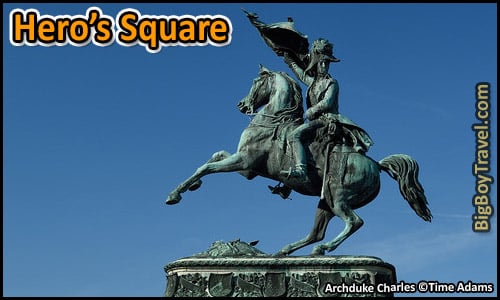
About Hero’s Square : As enter the large Hero’s Square ( Heldenplatz ) you’ll quickly get drawn to the backdrop of the beautiful Neue Burg Wing ( New Castle ), but the square itself is worth investigating. Heldenplatz and 2 other large gardens ( Burggarten & Volksgarten ) were laid out after parts of a Medieval castle wall that stood here were destroyed Napoleonic Wars.
While the other Gardens in Vienna have remained green, most of Heldenplatz has been paved over during the decades. Luckily a couple of the original equestrian statues still remain in the square. The first great statue is Archduke Charles of Austria riding a horse while triumphantly holding a flag. The statue of Charles, erected in 1860, was meant to portray the Habsburg Dynasty as great Austrian military leaders.
While the statue of Archduke Charles is cool, our favorite is of Prince Eugene of Savoy which sits right by Neue Burg’s main entrance. Eugene left France for Austria after being denied entrance to their military for appearance and went on to become the greatest General in Austrian history. He led military campaigns for 60 years over 3 different Holy Roman Emperors based out of Vienna and was very successful. Eugene’s claim to fame with battles over the Ottomans later gaining heavy praise fro Napoleon all while getting super rich from his endeavors. To this day Eugene serves as a point of Austrian pride and willpower.
If you want more of a true garden experience visit the People’s Garden ( Volksgarten ) on the Northern end of Hero’s Square. This garden, featured in our Vienna Ring Tram Tour has a wonderful rose garden, a replica of the Greek Temple Hephaestus ( Theseion ), and a memorial to Empress Sissi.
Before leaving Heldenplatz, make sure to check out the huge gateway going over the road on the South side of the square called Outer Castle Gate ( Äußeres Burgtor ) . The columned gateway is all that remains from a curtain wall built around the Palace in 1817 after the original castle wall was damaged during the Napoleonic Wars in 1809.
This new Palace wall section didn’t last long as it and the entire Medieval wall that surrounded all of Old Town Vienna were torn down in 1860 by Emperor Franz Joseph I to making way for the Ringstrasse loop. This move helped the growing city expand and was part of a large series of enhancements the Emperor made to the City.
23. New Royal Palace ( Neue Burg ):
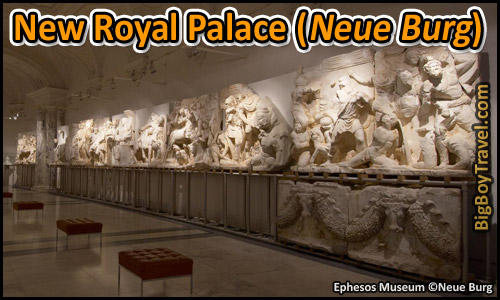
About The New Royal Palace : Emperor Franz Joseph’s had a dream of creating Kaiserforum complex to how off Austria’s might through architecture and arts. As seen in this 1865 mockup sketch , the complex covered the Neue Burg Wing ( or New Castle ) wing of Hofburg Place, the Museum Quartier, and numerous other buildings.
The huge Neue Burg section was started in 1881, but its construction was drug out for over 30 years into the beginning of WW1 which Austria lost, further delaying the project. Because of the lengthy, delays most of the rest of the Kaiserforum complex was scrapped for the most part, but overall the completed buildings are really impressive.
Once inside Neue Burg, it is easy to be in awe of the marble-lined corridors, grand staircases, and our favorite is called the Hunting Plateau which is a common place for weddings. The amazing details of the grand Neue Berg make it the perfect setting for the building many museum collections. The 1st collection that was housed here came from Archduke Franz Ferdinand in 1908 after he got back from an extensive trip around the World. After Archduke Franz Ferdinand was assassinated in 1914, which sparked WW1, his entire collection was given to Neue Berg giving a starting to a series of wonderful museums.
Today the building houses Papyros Museum, Ephesos Museum ( website ) , Collection of Ancient Musical Instruments and the Collection of Arms and Armor ( website ) which takes up the entire Southside. Our favorite of these museums is the Ephesos which has a great collection of classical and even ancient statues. The highlight of the Ephesus Museum is the Parthian Monument, part of an antique altar erected at Ephesus ( modern-day Turkey ) during the Hellenistic Period. In Roman times, Ephesus was the capital of the Province of Asia and one of the largest early-Christian communities in the world with around 200,000 inhabitants.
Neue Burg Museum Hours : Wednesday-Sunday 10am-6pm; Closed Monday & Tuesdays. If you only have time for one museum stop, consider the world-class collection of museums at nearby Museum Quartier instead of Neue Berg. Museum Cost : 15€ for Adults; Children are free; and guided tours are 3€ extra. Your ticket covers all of Neue Burg’s Museum plus the Art History Museum ( Kunsthistorisches ) in Museum Quartier. You can also get a combo ticket to include the Natural History Museum and Leopold Modern Art Museum for a couple of euros more. We’ve bought the combo ticket and they let us see the two museums on different days, but ask to make sure. Neue Burg Website : Here .
24. Museum Quartier :
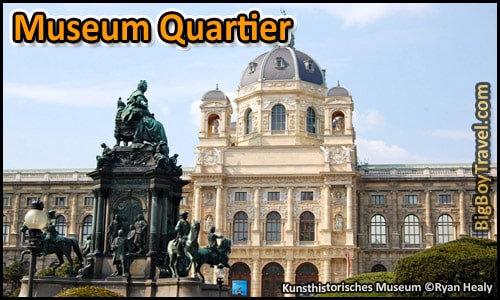
About Museum Quartier : As Emperor Franz Joseph designed his grand Kaiserforum complex, a series of museums built around a park was an integral part of his plans, but is was never fully completed. As seen in this 1865 mockup sketch , there were to be a ton of buildings, but at least the 2 large museums they did finish turned out to be masterpieces.
On the Eastside of the square is the highly rated Art History Museum , or Kunsthistorisches ( website ), which holds Vienna’s greatest collection of paintings covering very fun loving art from over a 200-year span. The Koonst as it’s called, also holds an amazing Egyptian Museum.
The twin building on the Westside of the Maria Theresa Square is the Museum of Natural History , or Naturhistorisches ( website ), whose vast collection holds Austria’s most famous work of art, the 4-inch-tall Venus of Willendorf Statue. This statue depicts a chubby, naked female figure carved into limestone and dates back to 24,000-22,000 BC.
Behind these two massive main museums is a third section worth a stop for any modern art lover, the Leopold Modern Art Museum ( website ) & Mumok Museum . Of favorite piece at the Modern Art Museum comes right away and is an upside down house home smashed into the side of the Museum called House Attack.
Art History Museum Hours : Tuesday-Sunday 10am-6pm; on Thursday until 9pm; Closed Mondays ( except June & August ). Art History Cost : 15€ for Adults; Children and teens are free, but a guided tour is +3€ and audio guide is +4€. Combo ticket with Neue Berg and Imperial Treasury is 20€ -or- with Neue Berg and Modern Art Museum is 24€. Natural History Museum Hours : Wednesday-Monday 9am-6:30pm; Wednesdays until 9pm; closed Tuesdays; best before Noon. Tours in English are every Friday, Saturday and Sunday at 3pm. Natural History Museum Cost : 10€ for Adults; Children and teens are free, but a guided tour is +3€ and audio guide is +4€. Modern Art Museum Hours : Tuesday-Sunday 10am-6pm; Thursdays until 9pm; closed Mondays. Modern Art Museum Cost : 13€ for Adults, students 8€, buy a mobile ticket online HERE . Combo ticket with Kunsthistorisches and Neue Burg is 24€.
Other Sights Near Old Town Vienna:
25. ringstrasse tram tour :.
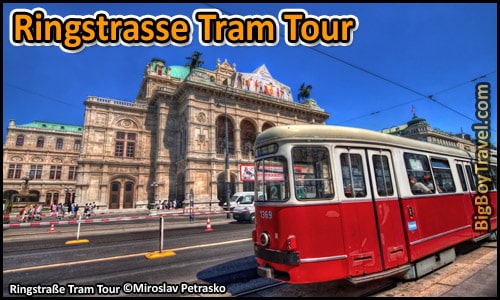
About The Ring Tram : When Vienna’s original Roman wall was expanded outward in 1257, it followed the path of today’s Ringstrasse. This new wall was very heavily fortified with watchtowers & bastions, was surrounded by a moat, and ringed with a wide building-free meadow ( glacis ) separating the city from the suburbs. This protection helped Vienna fight off the Turkish Sieges of 1529 & 1638 which may have saved the rest of Europe from being overtaken.
In 1860, the growing city of Vienna needed more room so Emperor Franz Joseph I tore down the Medieval wall and filled in the former moat that circled old town to create today’s grand boulevard. This was a boom time for Vienna and grand buildings sprung up all along the new Ringstrasse circling around Vienna.
Thanks to a modern system of tram lines, making the mile loop around the Ringstrasse to check out the sights is super easy. The entire loop can be done in less than 30 minutes , but we suggest hopping off at various points to explore and fully experience the Ringstrasse attractions. To help make your trip a smooth one we have put together a great guide to the best sights and tips for using the trams along with a helpful printable map.
Read More : Vienna Ring Tram Tour .
26. Saint Charles Church ( Karlskirche ):
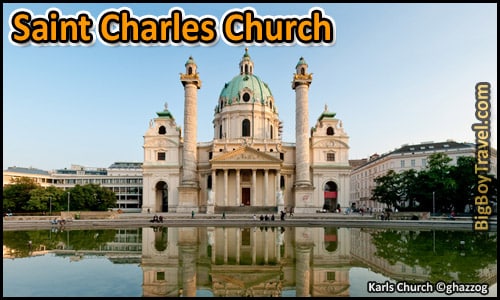
About Saint Charles Church : The giant white St. Charles Church dates back to the early 1700s and is a favorite of photographers with its large green dome and huge reflecting pool . The Church was commissioned by the Emperor after Vienna’s last bout of Plague as he felt that his prayers were the reason why the Plague stopped. This train of thought was a common theme throughout Vienna’s history as after each tragedy the ruling Emperor would use the event as a reason to build an even bigger and more extravagant Church.
Cost : 4€. Hours : Daily 9am-7pm. Website : HERE .
27. Naschmarkt :
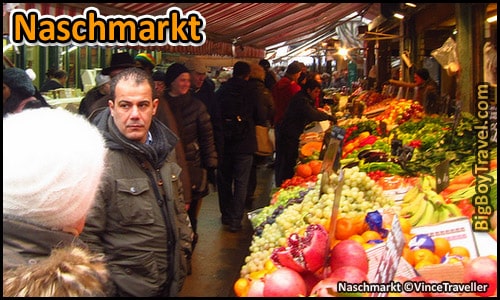
About Naschmarkt : The 6 block long Naschmarkt is Vienna’s most popular produce market. An active market has been operating here since 1780 and today has 100 vintage stalls.
Cost : Free. Hours : Stalls open Monday-Friday 6am-7:30pm; Saturday 6am-6pm; food & drink Monday-Saturday until 11pm. Website : HERE .
Featured Article

Sign Up For Our Newsletter For Free Travel Tips
Email Address *
Disclaimer: Information on this page and in our walking tours were deemed accurate when published, however, details such as opening hours, rates, transportation, visa requirements, and safety can change without notice. Please check with any destinations directly before traveling.
This website uses cookies to improve your browsing experience and analyze the use of the website. Learn More

Vienna Walking Tour Map

This free, self-guided walking tour is a companion to a free audio tour of Vienna's historic center.
This tour will cover important information about several notable landmarks and locations in Vienna.
But, if you’re looking for an even more in-depth experience, consider downloading the audio tour as well.
SELF-GUIDED TOUR OF VIENNA
If you don't enter any buildings along the route, this tour takes approximately 60-75 min depending on your pace of walking.
We based this route on the free audio tour from Rick Steves . Our content is unique, but we recommend listening to his well-produced tour.
You can also download his free tour wherever you get podcasts or simply download his Audio Europe app.
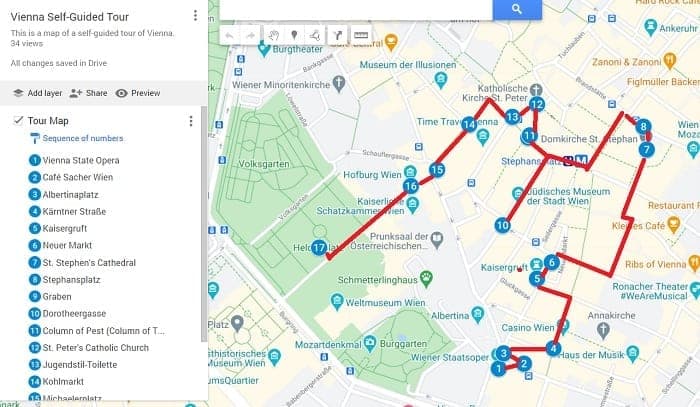
He also offers several travel books for the city. Just check out Rick Steves Vienna on Amazon ( Disclosure ).
And be sure to check out our other free walking tours of Vienna .
Here is our main schedule. More tour options are available here .
Searching Availability...
Vienna State Opera
Built over a period of 8 years from 1861-1869, this Renaissance Revival venue has been hosting wonderful operas for over a century.
Originally, this location was known as the Vienna Court Opera, but following the formation of the First Austrian Republic in 1921, they adopted its current name.

This is also the home of both the Vienna Philharmonic and the Vienna State Ballet. During Carnival, the Vienna Opera Ball is hosted here.
Although the Vienna State Opera was set ablaze by an American bombardment during WW2, it would later be restored and reopened in 1955.
This is one of the busiest opera houses in the world, producing 50+ operas and ten ballet productions for a grand total of 350 or more total performances -- almost one per day!
Cafe Sacher
This cafe is the home of a famous cake known as the Sacher-Torte. The original cake was crafted in 1832 when Prince Metternich requested a dessert for a special occasion.
The chef was ill at the time, so he had his 16-year old apprentice Franz Sacher take over.
The result was a delicious cake which became a favorite in Vienna for years to come.
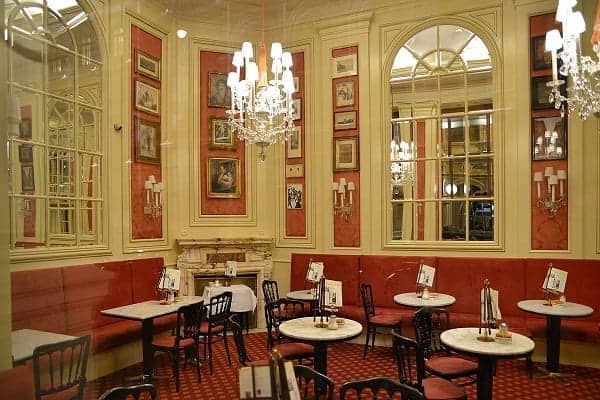
Over the years, locals have said that the quality of the cake decreased, but Cafe Sacher uses the same recipe to this day, so maybe it’s just the tastes that have changed?
Whatever the case may be, this would be a great place to stop in for a snack before continuing your tour.
Albertinaplatz
This public plaza is filled with interesting things to see and lined with several notable sites such as the Albertina museum, the Vienna State Opera House, Cafe Mozart, a Schanigarten and more.
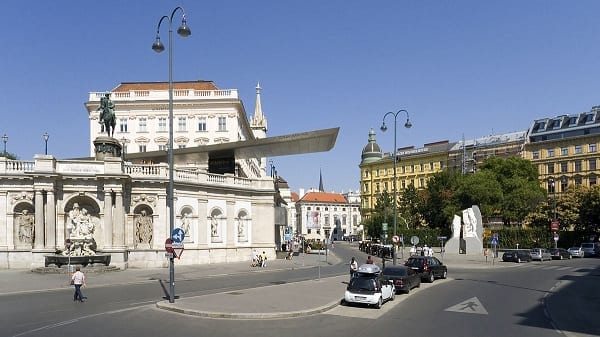
There are also a lot of statues on Albertinaplatz, including the Monument Against War and Fascism, which addresses the history of the Nazi occupation in Vienna while speaking out against all forms of war.
The split white stone monument is called the Gates of Violence, and it symbolizes the gates of a concentration camp.
The statue with his head in stone is Orpheus, and he is a reminder of the dangers of ignoring the rise of fascism.
The figure hunched on the ground is a Jew being forced to scrub anti-Nazi propaganda off the street.
This monument is located on Albertinaplatz for good reason, as this is the site where bombs once struck during WW2 and buried hundreds of innocent people.
Karntner Strasse
This street is the old shopping district of Vienna, and it is lined with several interesting stores.
In addition to all the great shopping, you can also enjoy some people watching while you’re in the area.
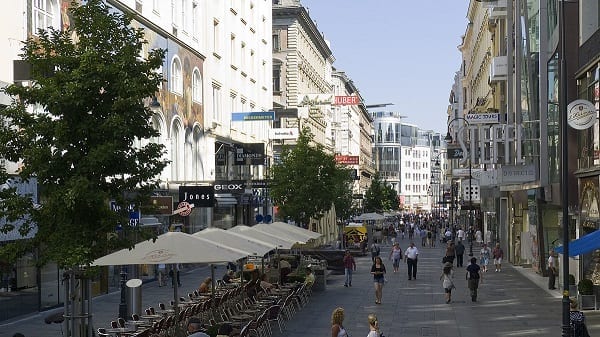
Some of the stores in this area can be quite expensive, so unless you’ve got plenty of money to spend, we recommend taking a look around and enjoying the atmosphere.
There is also a free glass museum above the J&L Lobmeyr Crystal shop, and this could be a great location to visit if you’re looking for fun and affordable activities.
Kaisergruft
This historic church is the home of a crypt which houses the tombs of Hapsburg royalty, including both emperors and empresses.
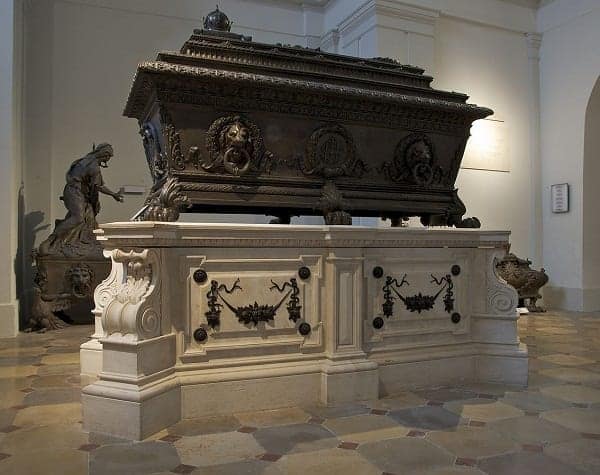
The crypt is filled with free standing sarcophagi which each have incredibly ornate and detailed designs, including decorative sculptures, reliefs, engravings and more.
The Kaisergruft is open daily from 10 am - 18:00 (6 pm) and tickets are fairly affordable at €7.50 for adults and €4.50 for children and teenagers under the age of 18.
They also offer guided tours for an extra €3.50 per ticket.
Neuer Markt
Also known as the New Market, this public square is lined by notable buildings like the Kaisergruft and there is also a great attraction here as well.

The Four Rivers Fountain is located at the center of Neuer Markt, and it symbolizes the rivers that flow into the Danube. The fountain was designed by Georg Raphael Donner in 1739.
There are also a few notable hotels in the area including the Hotel Ambassador on the former site of the flour depot and Hotel Meissl & Schadn where Friedrich Adler shot Prime Minister Karl Stürgkh in 1916.
St. Stephen’s Cathedral
Built in 1160, this is the mother church or the Roman Catholic Archdiocese of Vienna.
It’s also the seat of the Archbishop of Vienna. This is arguably the most important religious building in the city.
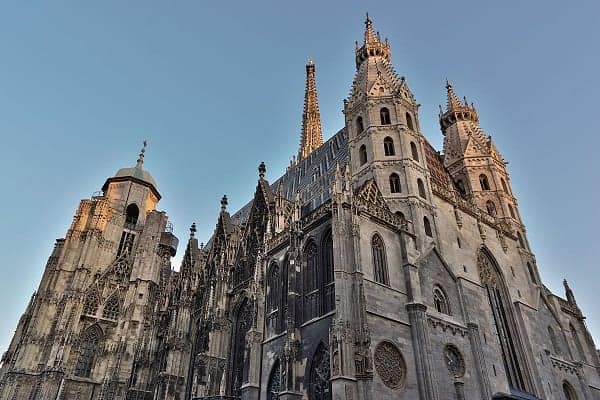
As with most churches this old, it has seen a number of renovations over the years which have given it multiple different architectural styles including Romanesque and Gothic.
This has been the site of many historic moments, but one of the most notable events was when famed composer Ludwig van Beethoven discovered he was deaf as birds flew out of the bell tower.
In addition to the church, this is also the site of tombs, catacombs and crypts, including the tombs of Prince Eugene of Savoy and Emperor Frederick III.
Stephansplatz
This is the public square in front of St. Stephen’s Cathedral.
There are a few things of note to see in this area, including beautiful architecture and even a tree trunk from the middle ages.
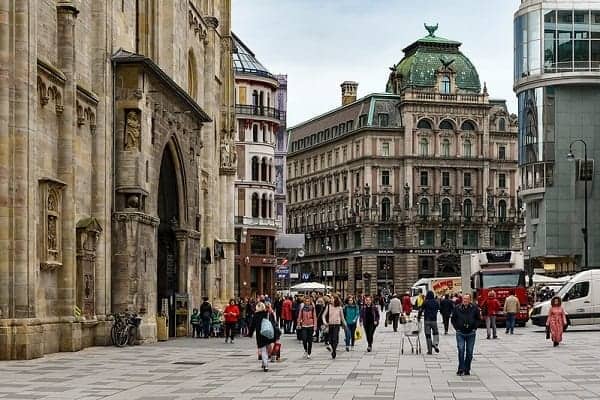
The Stock im Eisen, also known as the Staff in Iron, is a section of a tree trunk which has been hammered with hundreds of nails over many centuries.
The earliest written mention of this attraction dates back to 1533.
If you look opposite from the cathedral, you’ll see the Haas-Huis, a unique house built in the postmodern architectural style by Hans Hollein in 1990.
This is one of the most notable streets in the city centre of Vienna, dating back to the 12th century and absolutely filled with interesting history.
Think of this as the main street of the city. It has been used in centuries past as both a marketplace and a site for festival processions.
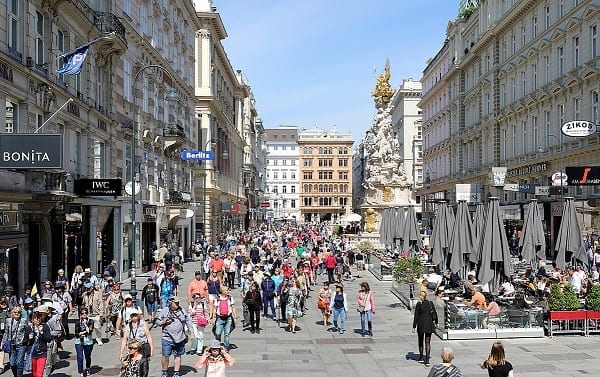
The buildings in this area are mostly known for their owners.
The Freisingerhof is named after the See of Freising who owned it in the 12th century and used it as the administrative centre of his estates in Vienna.
The Ankerhaus, built in the 1890’s, was owned by Otto Wagner, who also built the Grabenhof in 1873 with Otto Thienemann.
This is also the site of the Palace of Barons Bartolotti bon Partenfeld, and it is the only remaining baroque structure on the Graben.
There are also two fountains here which feature sculptures of St. Joseph and Leopold, both of which were designed at the request of Leopold I.
Dorotheergasse
Named after the monastery of St. Dorothea, this narrow lane is part of the old town district in Vienna, and it’s also home to one of the oldest auction houses in the world, the Dorotheum.
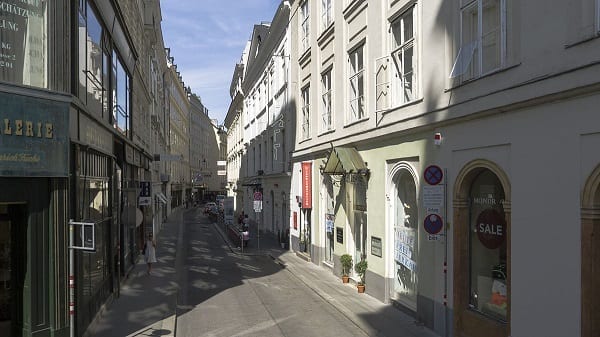
This is also where you will find the Jewish Museum of Vienna, which tells the story of Jewish history and culture in Austria.
This museum was founded in 1896, so it was well established by the time Nazi Germany entered Vienna, and at that time its contents were distributed to other museums.
Eventually, the artifacts and exhibits which were taken from this location were returned to the Jewish community beginning in the 1950s.
Admission to this museum is free with the Vienna Pass.
The Plague Column
This Holy Trinity column was erected on the Graben after the Great Plague in 1679.
This is an example of the baroque style, and it’s one of the most well known sculptures in the city.
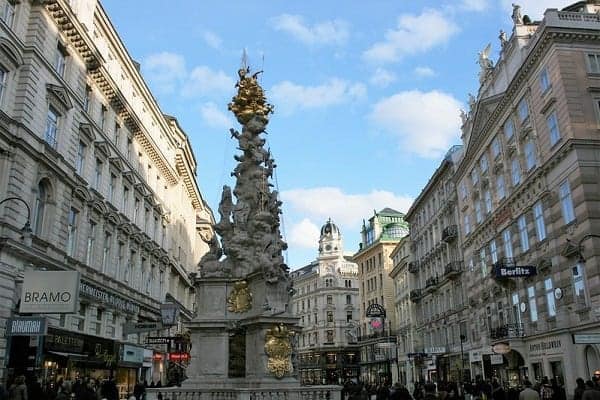
The top of the column is arguably one of the more ornate pieces on the structure, featuring dozens of angels, cherubs, baubles and of course a prominent cross being held out by a religious figure.
There is a lot of iconography all over the column, but the main message is that the plague was punishment for sin and it was stopped thanks to the piety and work of Leopold I.
Whether or not you believe Leopold’s faith was responsible for the end of the plague, this monument has an interesting mix of both religious icons and political propaganda which is definitely worth seeing up close.
St. Peter’s Church
This baroque Roman Catholic church was first built in the early middle ages, but nothing remains of the original building, and its most recent design was consecrated in 1733.
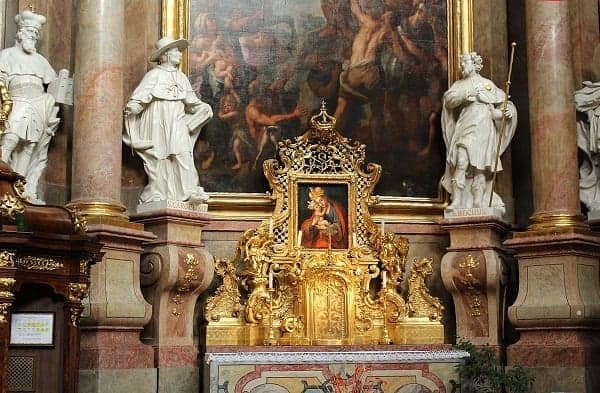
The concept for this church was inspired by St. Peter’s Basilica in Rome, which is one of the reasons why it also has a domed structure.
There are a lot of great things to see in the church, including the Coronation of Our Lady fresco, The Heart of Mary painting, and the beautiful baroque pulpit designed by Matthias Steinl, who also came up with the design for the dome.
If you need to take a break to use a restroom, there are actually some historic public toilets in the area which were not only designed to be very clean, but also quite beautiful.
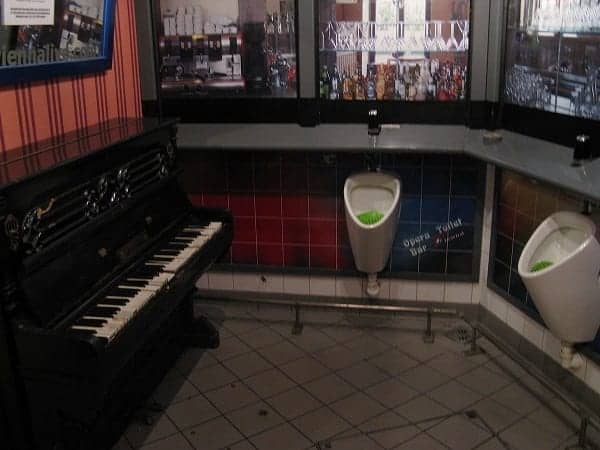
These were once wine cellars, but they were turned into restrooms in the early 1900’s by a chemist who wanted to prove the effectiveness of his chemicals for cleaning.
The WCs were designed in the modernist style. Originally they had chandeliers for lighting, but they have since been removed.
That said, much of the modernist design remains, and this is still a great place to stop and take a break if you need one.
This street runs from the end of Graben to Michaelerplatz, and there are at least a few notable shops you may want to visit while you’re in the area.
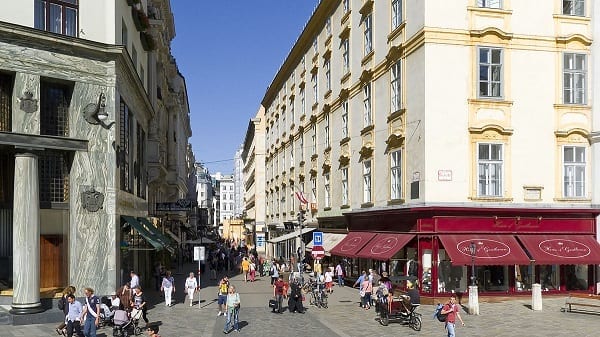
Of course, one of the first things you’ll notice is that Kohlmarkt is filled with upscale stores such as Armani, Tiffany, Gucci, and more.
Most tourists probably won’t want to stop in these locations, but if you’re looking for a treat, the Demel chocolate shop is halfway down the street.
This is one of the best places for chocolate in all of Vienna, and they have a lot of great sweets to purchase.
The former queen Sisi was said to have ordered her chocolates from Demel, and you may notice her image on a few different items in the shop.
Michaelerplatz
This is the site of the main entrance to the Hofburg Palace.
The square was named after St. Michael’s church, which is located right across the street.

They offer tours of the crypt of St. Michael’s which some might consider a bit creepy, as some of the corpses buried here are incredibly well preserved due to the climatic conditions and temperature of the location.
On the right-hand side of the church you’ll see Loden-Plankl, a 19th century shop where you can still find old-world apparel and traditional Austrian formal wear.
The street leading South from Michaelerplatz will take you back to Albertinaplatz, but there are still a few more stops to see before heading back.
The Hofburg Palace
Built in 1275, this is the official residence of the President of Austria, but it also houses several other noteworthy attractions you may want to visit.
Visitors will find a museum dedicated to the history of Queen Sisi, as well as a museum highlighting a collection of silver items.
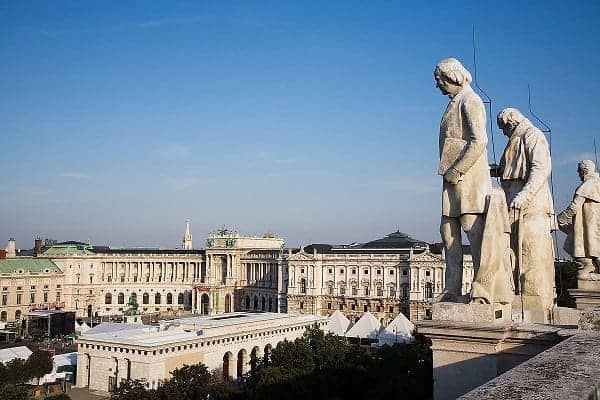
The Hofburg Palace is open from 10 am - 17:00 (5 pm) most days, and tickets start at €15 for adults and €9 for children between the ages of 6 - 18.
If you’re interested in seeing more, there is also a museum dedicated to the Imperial Treasury of Vienna and you can also visit the Spanish Riding School to see a demonstration of equestrian art.
Admission to each of these attractions is included at no extra cost with the Vienna Pass.
Heldenplatz
This public square is located on the other side of the Hofburg Palace, and it was actually the site of at least a few notable moments in history.

The most infamous event that took place here was when Adolf Hitler made his announcement that Vienna had been annexed into Nazi Germany on March 15th, 1938.
There are also two equestrian statues in the plaza that you might want to see: one of Archduke Charles of Austria and another of Prince Eugene of Savoy.
This is also the side of the Burgot, a city gate dating back to the 1800’s.
On the left-hand side of the plaza, you’ll see the Neue Burg wing of the Hofburg Palace and the Papyrusmuseum.
On the Northern end of the plaza you’ll find the Volksgarten, which also has a rose garden that blooms quite beautifully in the summer.
Choose a Destination... I want them all PLUS general travel tips. Amsterdam Berlin Boston Charleston Chicago Dubai Lisbon London Los Angeles Miami Nashville New York City New Orleans Paris Philadelphia Prague Rome San Francisco Washington DC
About The Author

Stephen Pickhardt
North america, united kingdom & ireland, middle east & india, asia & oceania.
Vienna in 1 day – My self-guided walking tour + route map
Are you going to visit Vienna in 1 day and are looking for a tourist circuit to do on foot to see the most beautiful sites in Vienna? So, maybe my article will inspire you to organize and make the most of your day in the beautiful capital of Austria.
Indeed, I share with you for free my self-guided walking tour to follow on the attached Google Maps. This tourist circuit tours the most beautiful sites in Vienna . It makes for a simply perfect day to get a global overview of this wonderful city.
How to visit Vienna in 1 day?
We're not going to lie to each other: Visiting Vienna in 1 day is possible, but you have to make compromises. Indeed, it will be impossible for you to make the complete visits of all the monuments and museums.
However, to visit Vienna in 1 day, you still have several possibilities that allow you to discover the city as a whole:
- Vienna sightseeing bus tour
- Guided tour of Vienna and its Opera
- Visit to Vienna and Sissi Castle
- or visit Vienna on foot following my tourist circuit, the details of which you will find below. It will take you a full day and will allow you to see most of Vienna. See details of the itinerary below.
Can you visit Vienna on foot?
When I planned my city tour, I wondered if it was really possible to visit Vienna on foot? Are the tourist sites close enough to each other, where are the most beautiful monuments located, can we take a walking tour to see everything?
Well yes, apart from Schönbrunn Palace which is a little out of the way but accessible by metro, the most beautiful monuments in Vienna are close enough to discover them on foot. In addition, there are many horse-drawn carriages that one can take to get from one site to another.
For your information, the short route of Vienna on foot that I present to you below is only 8 kilometers long and divided into two:
- 4 km course in the morning (50 minutes walk)
- Lunch break
- 4 km course in the afternoon (50 minutes walk)
Program and itinerary for your day in Vienna
When you only have one day, you have to resign yourself to only visiting the must-see sites in Vienna without visiting all the museums. Thus, you will be able to discover the majority of the most beautiful monuments and mythical sites but on condition of following an optimized itinerary to see everything in 1 day.
For this unique day in Vienna, here is the program and the itinerary which allows you to visit the city on foot following my self-guided tour (to download for free):
Vienna Opera
Mozart's house (mozarthaus).
- Vienna's St. Stephen's Cathedral (Stephansdom)
- The Hofburg Imperial Palace
Heldenplatz Square
- The Museum Quarter + Academy of Fine Arts Vienna
- Saint-Charles-Borromée Church next to the Resselpark
Belvedere Palace
Schwarzenberg palace.
- The Konzerthaus
- The statue of Johann Strauss in the Stadtpark
Schönbrunn Palace (Sissi Castle)
Vienna self-guided walking tour map.
Here is the Google Maps route map to download for free and to follow in pedestrian GPS mode:
Morning tours of Vienna
The morning route represents 4 kilometers of walking. So you have to leave early to be able to see everything!
It is with an emblematic monument of Vienna that we will begin my tourist circuit: the Vienna Opera.

In Renaissance style, it was built between 1861 and 1869 by the Viennese architects Eduard van der Nüll and August Sicard von Sicardsburg.
St. Stephen's Cathedral
From the opera, take Kärntner Strasse to reach St. Stephen's Cathedral in 15 minutes on foot.
Its gothic tower is 137 meters high and can be seen from any corner of Vienna.
Right next to the Cathedral, at no. 5 rue Domgasse, is Mozart's House. Indeed, it is there on the 1st floor, that Mozart lived between 1784 and 1787.
Hofburg Imperial Palace
My circuit takes us a 15-minute walk towards Burggarten Park. You will arrive at the Hofburg Palace which was one of the residential palaces of the Habsburgs. Successive Austrian royalty stayed here during the winter months for nearly 700 years.

You may be able to choose to take a tour inside the Palace: Sissi Museum, Imperial Apartments, Spanish Riding School or Imperial Treasury of Vienna.
Next to the Hofburg Palace is the Heldenplatz square, which is a historic square in Vienna. From this Heroes' Square, you will have a view of the Vienna Parliament and the town hall. And you can also access the Museum of Art History through the Burgtor door.
Museumsquartier
A few 800 meters to go by taking the street via Bellariastrabe and you will be in the heart of the Museum district. It is one of the largest cultural complexes in the world where many private museums are concentrated.

If you only have to visit one, I recommend the Kunsthistorisches Museum which is one of the finest fine arts museums in the world.
Church Saint-Charles-Borromée
Continuing on Getreidemarkt then taking the direction of Teich vor der Karlskirche, you will arrive after a 15-minute walk at the Church of Saint-Charles-Borromée. It is in fact an 18th century cathedral built during the reign of the Habsburgs. It was Emperor Charles VI who had it built in homage to Bishop Saint Charles Borromeo.
Afternoon tours of Vienna
After a well-deserved lunch break in or around the Park, you will continue the circuit by heading towards the Belvedere Palace (a 20-minute walk from Saint Charles Borromeo Cathedral).
The Belvedere Palace is one of the most beautiful Baroque castles in Vienna. It houses collections of exceptional paintings including major works by Gustav Klimt, Egon Schiele and Oskar Kokoschka.
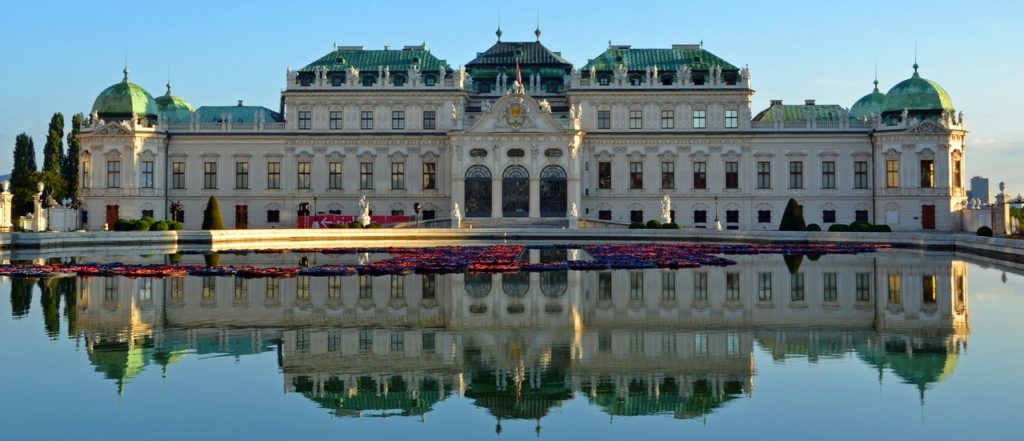
Crossing the magnificent Belvederegarten park of the Castle, our circuit brings us back in 15 minutes on foot to the Schwarzenberg Palace. This baroque palace belongs to the princely family of Schwarzenberg, whose current heir is Prince Karl VII of Schwarzenberg.
Vienna Konzerthaus
600 meters from the Schwarzenberg Palace is the Vienna Konzerthaus. It is a superb concert hall which was built between 1911 and 1913 under Emperor François-Joseph.
Stadtpark with the Statue of Johann Strauss
You can then reach the Stadtpark (400 m) to take a photo of the Statue of Johann Strauss. You will also be next to the Stadtpark underground station.
From the Stadtpark metro station, you can take the U4 line to reach Schönbrunn Palace in 11 minutes by metro.

This castle is one of the most visited tourist sites in Vienna. Listed as a UNESCO World Heritage Site, everyone knows it because it is Sissi's castle!
In fact, this castle served as a summer residence for the Austrian emperors and of course for Emperor Franz Joseph I and his wife Elisabeth of Wittelsbach known by the nickname of Sissi.
Where to stay to visit Vienna on foot?
For a short weekend in Vienna, I recommend that you avoid the neighborhoods of vienna too far from the historic center. Indeed, if you only have one day to visit Vienna, your hotel must be located very close to the monuments to visit.
The two most beautiful and convenient areas for tourists are:
- Inner city (the 1st district)
- New Build in the Museumsquartier (7th district).
Which hotel is well located for visiting Vienna on foot?
Right next to the Museum Quarter, the Mariahilfer Strasse shopping street and the Neubaugasse metro station, here is a hotel whose location is ideal for visiting Vienna on foot: HENRI Hotel Wien Siebterbezirk .

For tourists who don't have a big budget, here is a hotel with very good value for money. It is convenient for visiting Vienna on foot and is not far from the West station, metros, trams, buses.
Other weekend ideas in Europe? Cheap weekend in Marseille , The Bordeaux wine route in 2 days , Weekend in Amsterdam , Weekend in Lisbon , Romantic stay in Collioure
Similar publications

Lisbon in 2 days - Walking tours + essential itinerary map

Dublin neighborhoods to avoid and best places to stay

Where to go in Ibiza to party - Where to stay in Ibiza near the best clubs

Dangerous neighborhoods in Warsaw and the best areas to stay
Leave comments cancel reply.
Your email address will not be published. Required fields are marked with *
3 thoughts on “Vienna in 1 day – My self-guided walking tour + route map”
Mostly ordered by this roteiro, it was ordered no later than 14/03/24. Add all of this information as well. Gratidão
Hi, just wanted to say that the photo depicting the “opera” above is in fact Burgtheater 🙂 Greetings from Vienna!
Thank you Louise for alerting me. I made the change. Have a nice day!
- Things to do
- Vienna Card
- Where to stay
- Restaurants
Map of Vienna
Places of interest detailed in our guide, maps and guides to vienna.
If you are planning your trip to Vienna, you can find all the places of interest that we recommend you visit and other useful points of interest for your trip, such as the airport , on the interactive map on this page. Simply click on the placeholders in the map, or in the list just below, to go to the in-depth tabs of the individual point of interest.
Buy travel guides on Amazon
However, if you are used to organising your itineraries with a traditional paper guide, buy one of the following.
PDF travel map of Vienna
If you are looking for a map of Vienna that you can download and print out, here you will find a handy tourist map of the city with Vienna’s main attractions and underground lines.
Click on the preview to download the map in PDF format.
Underground map of Vienna
If you will be using the underground to get around during your stay in Budapest, take a look at the map of the lines to better plan your trip; to view, download and print it as a PDF file, click on the button below.
Where Vienna is located
Vienna is the capital of Austria and one of Austria’s nine provinces. The city lies on the Danube River in the eastern part of Austria and is close to the borders with the Czech Republic, Slovakia and Hungary.
Vienna has a long history, dating back to the first millennium; it has a population of about 1.8 million and is the largest city in Austria. The city is known for classical music, opera and ballet, and is also home to numerous museums and art galleries.
How to save on transport and entrance fees
City Card allow you to save on public transport and / or on the entrances to the main tourist attractions.
- Airport transfers
- Airport parking
Account Options


Vienna Walking Tour Maps City Center
The city center is a perfect place for a walk and the easiest way is to simply follow one of the routes from the free city-walks Vienna walking tour maps . Many historic buildings and monuments offer an impressive contrast to a few new buildings in the old town of Vienna . Discover the most beautiful places and admire the marvelous facades of lovingly restored houses with history .
Walking Routes for Download & Printing
During a walking tour from city-walks you can not only admire numerous buildings and impressing monuments , but also relax at a stroll through one of the well-kept parks in the city center.
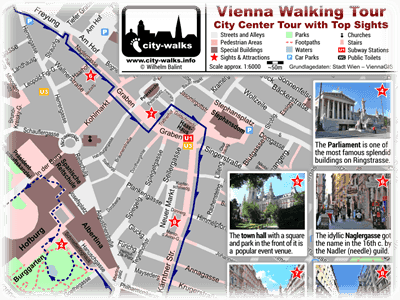
Rathaus and Rathauspark on the Route
Vienna Walking Tour City Center
This route through the city center leads you to the most important sights in the old town which are also marked in the free tour map . The course will take you through some romantic alleys as well as through large pedestrian zones . Additionally, beautiful parks with wonderful green spaces invite you for a relaxing stay during your stroll .
This is the ideal route for those who want to explore the city on foot . If you also like to spend some time with shopping , even this is possible as this route leads through the Graben and the Kärntner Strasse where you can find a lot of different shops .
Ringstrasse Sightseeing Walk
The Viennese Ringstrasse runs around the center with its historic inner city . In the 19th century the city wall was demolished and in this free area the Ringstrasse evolved. Many magnificent buildings and squares were built around this new boulevard .
During this sightseeing walk you will come upon the highlights of the ring road in the eastern section from the opera house up to the Urania . See the Konzerthaus where the famous New Year's Concert takes place, make a selfie with the golden Johann Strauss monument or find out which building in Vienna is called the Asparagus Castle . This and much more is all part of the walk , which takes about 2,5 hours .
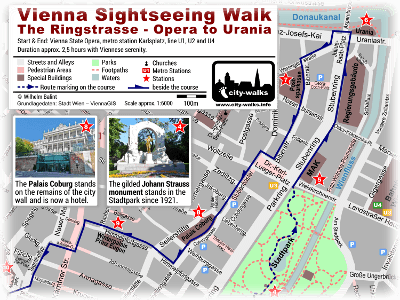
Urania on the Route
Song Contest Walk
The route for the tour starts at the town hall and leads you across the inner city until the Prater. During the walk you will pass different stations which have a connection to the two Austrian Song Contest winners Conchita Wurst and Udo Jürgens .
Perfect suitable for those who like to stroll through the city and discover some of the favorite places of the Song Contest stars . Fans have even the opportunity to make a Selfie with the "stars" at the end of the route.
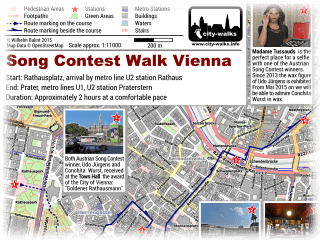
Kärntnerstraße on the Route
Tourist Map
Maps of the center for orientation and travel planning ...
Attractions
The top attractions in the center of Vienna with info and tips ...
Food & Drink
Recommendations for restaurants, cafes, bars and ice cream shops ...
Facts and figures about the city, tips for your journey and stay ...
Travel Guide
Overview of all the city-walks topics from which you can choose ...
The imperial spa town Baden is located only 25 km in the south of ...
Cheap Hotels
Do you want to book a hotel with a good price, situated in the center ...
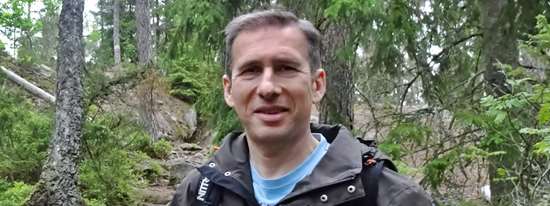
About city-walks.info:
Hello, my name is Wilhelm Balint . I am the author of this web page and the face behind city-walks.info . I love to experience the unique atmosphere of a city during a walk . Whether crowded tourist attractions or hidden sights , every place can look beautiful with the right viewpoint! city-walks.info should help you with tips and useful information to discover these beautiful views of the city. Read more ...
Imprint - Privacy © Wilhelm Balint
* This web page contains affiliate links / ads. More Information
Vienna Tourist Attractions Map PDF
Printable Map of Vienna Attractions, Walking Tours Map

Home / Vienna Tours / Attractions Map
Top 5 Must-See Activities in Vienna
These are the most famous Vienna tourist attractions & sight tours which sees thousands and millions of visitors each year:
Schönbrunn Palace Tickets
Belvedere Palace
Vienna City Pass
Spanish Riding School
Albertina Museum Tickets
Vienna Tourist Attractions Maps | City Tours Map
Vienna is a charming city that's rich in culture and history. It has its own unique charm and an interesting story to tell. When visiting Vienna, it's important that you plan your trip well. To help you in planning for your Vienna trip, we have provided a free copy of the Vienna tour map. The map will take you to explore Vienna's most famous attractions and discover what the city has to offer.
A Vienna interactive map is also available to download from our website. This is a highly interactive map of Vienna that's easy to understand and will serve as your guide in exploring Austria's capital city. If you want to go sightseeing at Vienna's top attractions , like the Schönbrunn Palace , Hofburg Palace, St. Stephen's Cathedral , the Giant Ferris Wheel and others, you can rely on the printable tourist map Vienna for directions.
The Vienna U-Bahn is the city's metro system and a more practical way to explore the city. To guide you into using the metro, check out our Vienna metro map with attractions. It will tell you what train to take and what station to get off when visiting the city's top attractions.
Regardless of how you prefer to explore Vienna, we have a map that's available for you to use for free. For tourists who prefer to discover the city by foot, you should get a copy of the Vienna tourist map walking. If you're interested to take the hop on hop off bus and wondering where the bus will take you, then the Vienna hop on hop off bus map is a great help for you.
The printable map of Vienna should come in handy for travellers who want an actual copy of the map of Vienna instead of relying on the Vienna tourist map pdf. Visitors who are travelling to Vienna for the first time, take the Vienna hop on hop off bus , then check out the hop on hop off bus map so you will know where the bus would stop. This map lists down all the famous attractions in Vienna including tips on how to visit these attractions.
Whether you are visiting Vienna for the time or not, you can certainly benefit from the use of Vienna tourist map printable. These Vienna city sightseeing maps will serve as your guide into exploring the city on your own.
- Interactive Vienna Attractions Map
- Top Rated Vienna Attractions
Vienna Sightseeing Bus Tour Map
Vienna big bus map, vienna metro map, vienna transport map, vienna tourist map, vienna walking tour map.
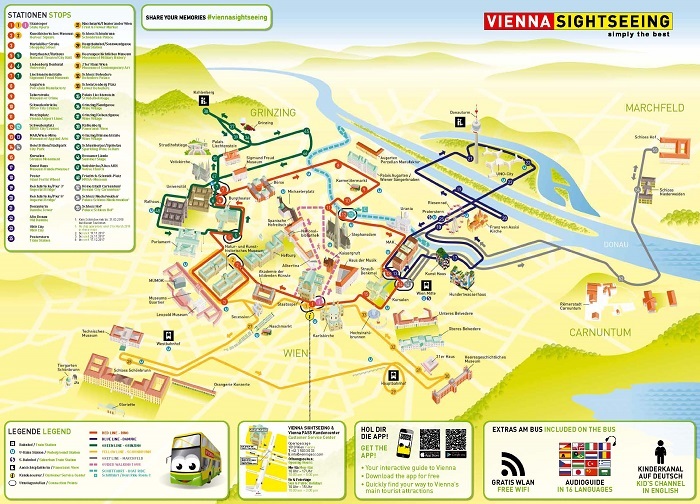
Top Vienna Attractions Skip-the-line Tickets & Tours
Vienna House of Music Entrance Ticket
Vienna Albertina Museum Ticket
Hard Rock Cafe Vienna with Set Menu for Lunch or Dinner
Entrance tickets for the KUNST HAUS WIEN. Museum Hundertwasser
Leopold Museum Vienna Entrance Ticket
Madame Tussauds Vienna
Vienna PASS Including Hop On Hop Off Bus Ticket
Time Travel-Magic Vienna History Tour Ticket
Top Incredible Travel Guides of Vienna

- Vienna Bus Map
- Vienna Nightline Bus Map
Vienna Attractions Map
Big bus hop on hop off bus map, vienna sightseeing tour map.
- Neighborhood
- Vienna Bike Route
- Citybike Stations Map

Vienna Tourist Map
You can find on this page the map of Vienna monuments, the map of Vienna tourist buses. Vienna is the capital of Austria and one of the most visited city in the Europe with 3.7 million tourists per year. Thanks to its numerous monuments, museums, sightseeings, landmarks and attractions, Vienna was declared World Heritage Site by UNESCO.
Vienna sightseeing map
In Vienna you can visit: • museums: Albertina, Leopold Museum • religious buildings: Karlskirche, St. Stephen's Cathedral, Votive Church • squares: Bergplatz, Heroes' Square • different attractions: Schönbrunn Palace, State Opera, Belvedere Palace
Vienna hop on hop off
The Big Bus of Vienna is an original way of visiting Vienna and discover its monuments, museums, attractions while getting on and off at your disposal. This concept of hop on hop off bus or open-top double-decker buses offers a network of 2 tourist tours and routes and 19 stops with commentary in 12 languages.
Hop on hop off bus vienna
The Vienna Sightseeing is a second hop on hop off bus company with open roofs to discover the city of Vienna via a tour. Vienna sightseeing offers a network of 5 lines commented and 45 stops in 16 languages.
- Vienna Travel Planning
- Vienna Notes Newsletter
- Help Centre: Ask a Question
Vienna Unwrapped Inspiration and Planning For Independent Travellers who are visiting Vienna
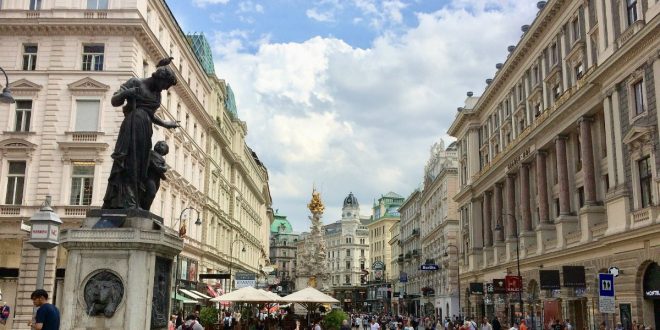
Vienna City Centre – The 4 Smartest Old Town Routes
- share
- save
- RSS feed
Just imagine a UNESCO World Heritage stretching across three square kilometres (1.16 square miles) – that is the Vienna City Centre. In fact, old town Vienna brims with history, palaces, classical music venues, coffeehouses and restaurants, and high-end shopping. When it comes to architecture, you will find a mix of Medieval, Baroque, Historistic, Art Nouveau, Modernist and sleek contemporary sites.
Before you visit Vienna , let me show you four smart routes to cover the best sites. To give you another head start, you will find a city center tour map below.
In German, we call the center of Vienna ‘Innenstadt’. Conveniently for visitors, the pedestrian area covers an entire 82,000 square metres (883,000 square feet). To get an idea of its shape, the city center is round and girded by Ringstrasse.
The Boulevard: Ringstrasse

Being back on Ringstrasse makes me proud and exhilarated every time I revisit my home city. It’s just so unique. You can find a detailed list of key buildings and sights, a map and how best to tour the boulevard in Ringstrasse Vienna .
Duration : 30 min (by tramway or bike)
Central Vienna: Kärntner Strasse
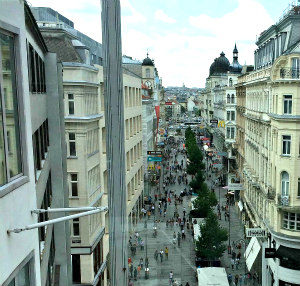
Kärntner Strasse high street is the main entrance of old town Vienna. It’s a lovely pedestrian area and full of street artists in the summer. Start with the Vienna State Opera . At Palais Todesco opposite Wiener Staatsoper drop into gorgeous Gerstner cake shop. If you like luxury enter the lobby of legendary Hotel Sacher or feast on Sacher Torte in its café behind the opera.
It actually took me years to look up from the shop fronts, like probably many other locals. The street boasts the most amazing historic façades, such as no. 16, a former hotel. If you are a fan of glitz, stop at Swarovski’s flagship store at no. 24, and traditional chandelier maker Lobmeyr at no. 26. At no. 19, the glass elevator of Steffl department store provides great views of Kärntner Strasse.
It takes you to Sky rooftop bar and terrace. That is where I shot some of my best pictures of the center of Vienna and Stephansdom.
Palais Eszterházy at no. 41 dates from the early 15th century. If you visit the Vienna Casino you can see the interiors but that is not a must.
Stephansdom and Graben Boulevard
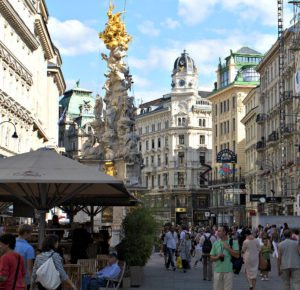
In Roman times, you would have walked on top of the city wall there. For me, the best way to enjoy Graben is relaxing in one of the outdoor cafés. That monument in the photo is the Pestilence Column in the middle of Graben. If you like baroque churches, drop into Church St. Peter, known for its Mozart Piano Sonatas .
You will also find a few traditional shops there. Many of them are former suppliers to the Imperial Court, for example Albin Denk (porcelain), Nägele und Strubell (beauty shop) and Altmann und Kühne (chocolate shop). Don’t miss fabulous deli store Meinl am Graben at the end.
Duration : 30 to 40 min; 1.5 hours inc. visit to Stephansdom; To extend your old town Vienna walk find inspiration and a map in Old Vienna Walk .
Imperial Palace
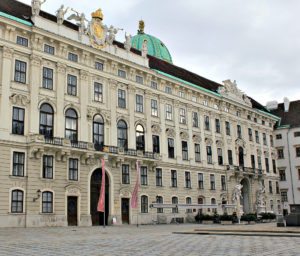
The Imperial Stables have turned into Museumsquartier which houses amazing Egon Schiele Museum , also known as Leopold Museum.
Even after hundreds of years, the traditional Lipizzaner stallions are still performing at the Spanish Riding School Vienna . Read more what to see and do and find a map of Hofburg in Imperial Palace Vienna .
Duration : 30 min (outside); 2 to 3 hours (inc. indoor visits)
Medieval Vienna: University Quarter
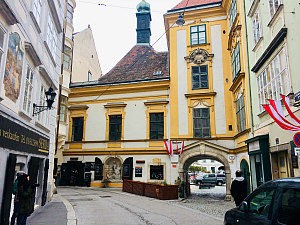
Right of Rotenturmstrasse, head into Lugeck and Bäckerstrasse. Drop into the courtyards at no.2 and no. 16, typical of the historic center of Vienna. Visit brilliant baroque University Church, also known as Jesuit Church, then turn into Sonnenfelsgasse. At Schönlaterngasse drop into the courtyard of Heiligenkreuz Abbey, then head for Fleischmarkt and Griechengasse. This part of the center of Vienna is dense with beautiful hidden corners, history and legends. I toured it with Regina, who runs the Secret Vienna tour .
In my student days, ‘left of Rotenturmstrasse’ was the utter place to go out in the Vienna city centre. It still is. I loved the bar almost opposite of the old Jewish Synagogue in cobblestoned Seitenstettengasse. Church St. Ruprecht – the oldest in Vienna – made a great backdrop to romantic endeavours. Historic Judengasse lead to the best sausage stand for midnight feasts.
Duration : 1.5 hours
Vienna City Centre: Best Guided Tours
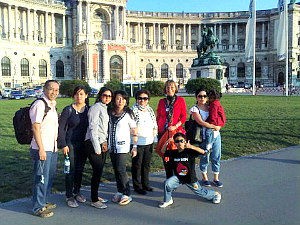
If you don’t mind larger tours and are on a budget, this popular two hour guided walking tour fits the bill perfectly.
Old Town Vienna Map
Here are the four routes I have described above. Click on the left arrow in the header field to find the legends. Use the + and – a the bottom left to zoom in and out.
find more Vienna Attractions – Which Places To Visit In Vienna
explore my favourite Vienna Tours – 5 Ways To See Tourist Places In Vienna find out whether you could benefit from Vienna Unwrapped’s bespoke Vienna travel planning service back to Vienna Unwrapped homepage
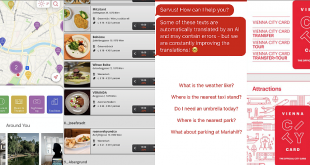
Resources You Need To Plan Your Vienna Vacation
To fast track your planning for a Vienna vacation I have packed a ton of …
Recommend article
Please complete all the mandatory fields marked with an * .
Recommendation successfully sent
Thank you for recommending our article.
The data and email addresses you provide will not be saved or used for other purposes.
- Email is a mandatory field.
- Please enter a valid email address.
- Email address valid
- Name is a mandatory field.
Subject: Recommendation from www.vienna.info
- Error: Please wait a moment, verification is still in progress.
- Error: Please try again. If the error continues to occur, it means we cannot identify you as a human being. You will not be able to send the form for security reasons.
- Share page Share on X Share on Facebook Share on LinkedIn recommend
You are here:
- Tours & Walks
Through the city with Vienna's tourist guides
Hardly anyone knows Vienna as well as the certified Viennese tourist guides. So if you think you already know (almost) everything about Vienna, then you should really consider going on one or more tours. It's worth it.
The best way to take a tour of Vienna is with one of the certified guides, who know the city better than the back of their hand. Tourist guides also offer much more than just city tours. They are storytellers, art historians, architecture aficionados, insiders, gourmets, jacks of all trades, and much more besides. A pretty good combination, wouldn't you say?
We have put together a selection of original and exciting tours by Viennese tourist guides for you:
On an architecture tour through Vienna
Architecturally speaking, Vienna can offer more than just Schönbrunn , St. Stephen's Cathedral , and the Ringstrasse . From Otto Wagner's magnificent Art Nouveau buildings (Majolica House or Church of St. Leopold) via the Bauhaus style ( Werkbundsiedlung ) to modern architecture ( WU Campus with buildings by Zaha Hadid or NO.MAD Arquitectos), there's a diverse architectural landscape waiting to be discovered.
Out and about in the neighborhood – Vienna for the Viennese
The Viennese love their neighborhood , but do they really know it as well as they think they do? Any gaps in knowledge can be filled on a district tour or neighborhood tour . Interesting not only for Viennese but also for visitors who'd like to take a really close look at their favorite district or other unknown districts.
On the Venusberg
Known, loved and famous for its picturesque Christmas market in winter, the Spittelberg and its wonderful Biedermeier houses can look back over a literally moving history. Previously also called the "Venusberg", establishments of somewhat dubious repute once existed here, in today's 7th district. With so many spicy details, you can satisfy your hunger in one of the numerous restaurants on the Spittelberg .
Fancy a coffee? Or two?
Perhaps you'd like a Melange or an Einspänner in between? The sweet side of Vienna can definitely be experienced over coffee and cake . Tourist guides have a few stories to tell about the city's legendary coffee houses .
Concealed corners with edges – and a lot of history
In Vienna, you'll stroll along convoluted and concealed paths: on this tour, you'll dive deep into hidden Vienna, which lets us dream of times long past with its enchanted stories. From Blutgasse (Blood Lane) via the Greek quarter to the old university quarter .
Death must be a Viennese
People like dying in Vienna. That may sound comical, but people here connect death with far more than grief. Things are likely to get a bit morbid . That's no surprise, because you can walk on guided tours through notorious cemeteries ( Central Cemetery ) as well as through enchanted final resting places ( Cemetery of the Nameless ).
Off to Mazzesinsel
What would Vienna be without its Jewish population ? On a guided tour through Jewish Vienna , you'll naturally learn all sorts of things about Viennese Jewry over the course of history, but also that the 2nd district was once called "Mazzesinsel". The area is still home to kosher supermarkets, butchers, and bakers, which pamper the palate with Jewish specialties .
The little ones on a great tour of discovery
Vienna is a big deal even for the little ones: From dragons and unicorns to Wolfie and Nannerl, from animal city life to imperial sweets. A city holiday with children is really fun with the right programme. In this way the kids, but also their parents, get to know Vienna in a playful way.
An overview of the tours:
Architecture tours
District tours
"Spittelberg" tour
"Coffee and Cake" tour
"Hidden Corners" tour
"Cemeteries" tour
"Jewish Vienna" tour
Guided tours for children
Or you can find many other guided tours at Guides in Vienna or your very personal guide to Vienna here .
Rate this article
Feedback to the vienna.info editorial team, thank you very much for your feedback.
Thank you very much for your feedback on our item.
1 error has occurred. errors have occurred.
- Salutation is a mandatory field.
- Message is a mandatory field.
Fancy more?
Exceptional vienna tours, lgbt city tour 2, lgbt city tour 1, guided shopping tours, ivie's walks & guides, vienna’s best courtyards, sightseeing by boat, tram, bicycle, social housing, guided bike tours, in the footsteps of the habsburgs, winter in vienna: a perfect day, photo series: heartbeat streets, filter results.

30 Little Gems in Old Town Vienna (See Them on a Map)
This post might have affiliate links. This means we could earn a small commission if you make a qualifying purchase. No additional cost to you. More info: Disclosure
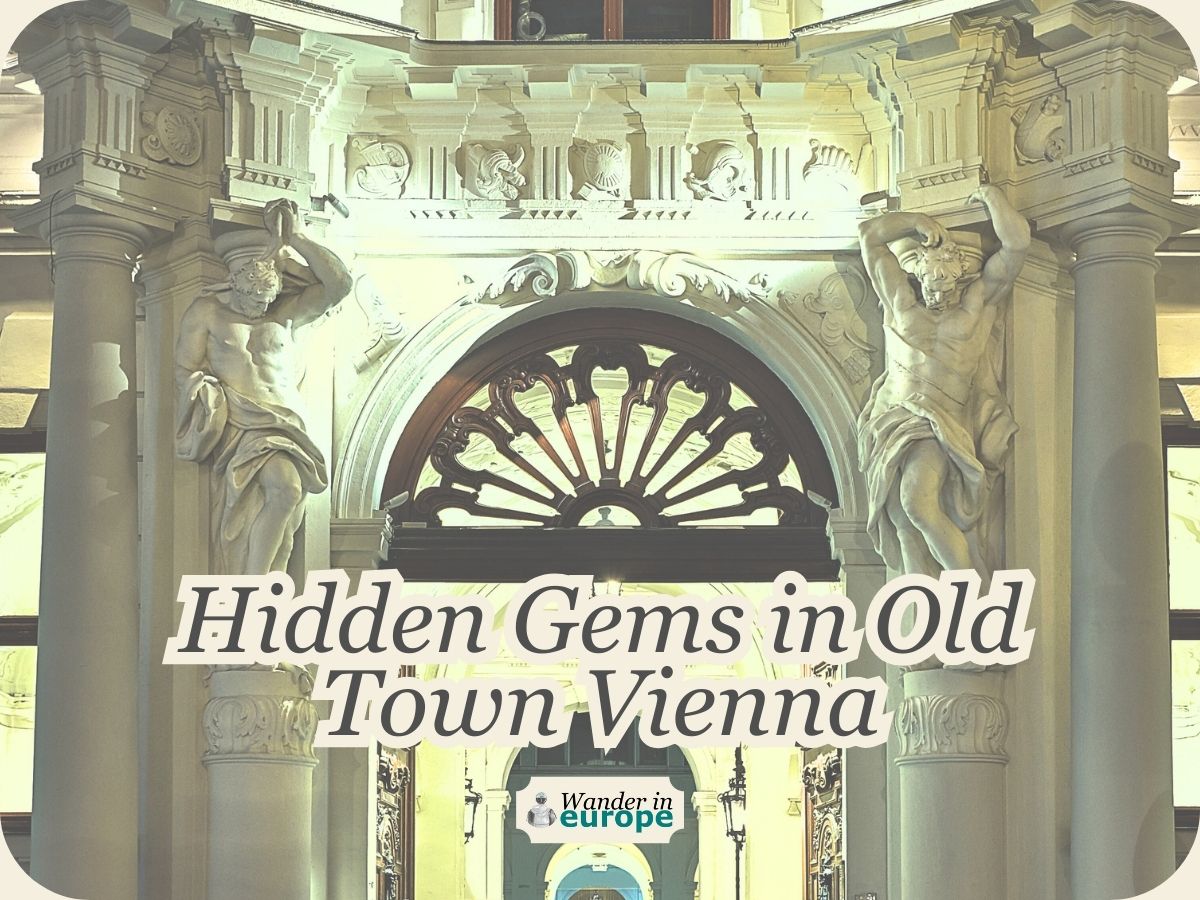
Truth: you could easily spend three or four days in Vienna just sightseeing.
In Old Town Vienna (Innere Stadt) alone, within the perimeter of Ringstrasse, a single day might not be enough to wander and see all the beautiful landmarks, historical sites, and intriguing museums! Believe it or not, that’s still the case even if we exclude the landmarks you’ll encounter during a walking tour of Ringstrasse or the architectural wonders in the city .
Indeed, there’s an overwhelming amount to see! For instance, these 30 lesser-known attractions or hidden gems I discovered in Vienna, which I’ll share with you today.
If you’re looking to uncover even the smallest intriguing details of Vienna or if you’re aiming to do something unique in Vienna , these attractions/city features are ideal for you to visit. I’ve included a map of these minor attractions in Old Town Vienna for you to conveniently find them.
Do you find trip planning a bit overwhelming, or are you seeking in-depth knowledge and cultural insights into Old Town Vienna? This top-rated Vienna Guided Walking Tour of the City Center Highlights is perfect for you! For a unique experience, consider the Vienna Spooky Ghost Tour . And for an exploration you’re sure to enjoy, our partner-certified 2-hour Historical Sightseeing Tour of Vienna is worth considering. For more amazing experiences in Vienna, this list is a must see .
Old Town Vienna Map
In summary, the sites displayed on these maps of Vienna are distinguished by their architectural beauty and historical importance. They include unique spots and museums associated with Mozart, Beethoven, the Holocaust, and more.
Below are three maps: (1) a comprehensive map of Old Town Vienna highlighting the locations of 30 lesser-known attractions; (2) a zoomed-in map of Old Town Vienna showing the points of interest near the Danube Canal ; (3) another close-up map of Old Town Vienna, revealing the hidden gems in parts of the Old Town Vienna away from the Danube Canal .
Jump into the description of each attraction by clicking their names.
Discover amazing ways to enjoy Vienna
Vienna Ringstrasse Walking Tour DIY (with Map and Tips)
Click to open in a new tab .
Old Town Vienna’s 30 Unique Things to Do (Little Gems)
If you’re short on time and can’t see everything in Old Town Vienna, you might want to focus on visiting the churches, palaces, and old government buildings. Also, don’t miss out on the beautiful sights on the streets like fountains, clocks, and scenic views.
For the palaces, don’t miss out on the Daun-Kinsky Palace and the Liechtenstein City Palace . As for the churches, be sure to visit Annakirche , Holy Trinity Greek Orthodox Church , Maria Rotunda Catholic Church , and the Jesuit Church . Other beautiful sights include the Old City Hall (Altes Rathaus), the Anker Clock (Ankeruhr), the Vienna Plague Column (Wiener Pestsäule), and Kohlmarkt , a very scenic street.
Tip: Look for four small Austrian flags hanging on the facade of some of these lesser-known attractions in Vienna. They’ll help you identify these hidden gems as you stroll through the historic center.
The list below is organized in the order corresponding to the numbers on the map. All the details about each attraction are conveniently linked and compiled in the resources section of this post for easy reference.
1. Alte Börse
While it seems you’ll see stunning architecture wherever you look in Old Town Vienna, some buildings just stand out. Amazingly, their exteriors aren’t the only eye-catching features. Step inside and you’ll treat your eyes to elegance and grandeur.
One beautiful example is Alte Börse , or the Old Stock Exchange , with its gorgeous Viennese neo-Renaissance style. You can find it along the Schottenring of Ringstrasse . Today, it hosts private institutions and events. Unfortunately, as far as I know, it’s not possible to tour inside on your own, which is a letdown.
However, concerts also take place here, specifically in Festsaal — the architectural highlight of Alte Börse ’ s interiors. The concert is an opportunity to see its interiors. Most importantly, it accomplishes two things: pleasing the ears and the eyes.
This is where you can check for concert tickets in various places in Vienna , including those at Alte Börse.
2. Schottenkirche
If you plan to visit the Kunsthistorisches Museum before exploring the beautiful lesser-known attractions in Old Town Vienna, you might already be familiar with Schottenkirche.
Freyung, the square where Schottenkirche is located, is depicted in a beautiful painting in the museum. This painting, created by Bernardo Bellotto, clearly shows Schottenkirche dominating the square’s view with its tower.
However, Due to Vienna’s turbulent past, such as the Turkish wars, Schottenkirche no longer retains its original appearance. You’ll notice this if you compare Bellotto’s painting to the actual view of the church from Freyung.
On the bright side, the interiors of Schottenkirche have been breathtakingly restored in a mix of Neo-Renaissance and Neo-Baroque styles. The beauty you’ll encounter inside, particularly the glass mosaic of the Virgin Mary on the altar and the intricate stucco work everywhere, is one reason why this church is a gem in Vienna.
3. Maria am Gestade Catholic Church
Did you know that, apart from Karlskirche , there are more architecturally interesting churches in Vienna?
One of them is the Maria am Gestade Catholic Church , which stands out for its tall and narrow design. Its 56-meter high openwork tower, styled in Gothic scrollwork , is a unique sight to behold. With its tower, you can easily distinguish this church from a distance.
Another two features that make this church a gem in Old Town Vienna are the beautiful stained glass windows in its choir and the intricate lacy stonework of the altar , which is quite eye-catching.
If you’re a history buff, Maria am Gestade has an interesting fact to offer: it’s been standing since the mid-12th century. Yes, it’s one of the oldest churches in Vienna and was the place where sailors of the Danube River used to pray.
You can find the Maria am Gestade Catholic Church at Salvatorgasse 12. The nearest bus stop is Schwertgasse.
4. Museum Judenplatz
Interestingly enough, Vienna hasn’t just been a home for Christians, but also for a community of Jews. As you wander through the Old Town, you’ll come across various monuments, landmarks, and even a museum that narrate their tale.
For instance, if you visit Judenplatz — the heart of the Jewish neighborhood in Vienna — you’ll find the Museum Judenplatz . It showcases the religious, cultural, and social living conditions of the Jews in Vienna throughout history, stretching back to the medieval ages.
In my opinion, this museum is a gem for those wanting to discover a part of Vienna’s history from a different perspective .
The most interesting part of the museum? It’s the excavated remains of a medieval synagogue that once stood in Judenplatz. The exhibition includes augmented reality features, giving you an idea of what it looked like when the synagogue was still standing.
5. Holocaust Memorial
As a human being, I find the Holocaust Memorial in Judenplatz to be one of Vienna’s most moving monuments.
This site, also known as the Nameless Library , is dedicated to the 65,000 Austrian Jews who were killed during the Holocaust . The design of the memorial? It effectively conveys their heartrending story.
From afar, it simply looks like a concrete block.
But upon closer inspection, you’ll see the details: The outer surface of the monument features shelves of books with their spines turned inward, symbolizing the countless stories that were never told . The doors of the library remain closed, symbolizing the inaccessibility of these untold stories .
6. Kirche am Hof
Kirche am Hof stands out as another architecturally fascinating church in Vienna’s Old Town, boasting a blend of styles . Its exterior is Baroque, the interior Gothic, and the choir? It’s Neoclassical. The Rococo stucco work on its three-aisled nave further enhances its charm.
While it may not be as breathtaking as other churches in Old Town, like the Peterskirche with its grand Baroque interiors, it certainly possesses an elegance that offers a serene and beautiful experience.
The fascinating aspect of Kirche am Hof lies not only in its architecture but also in its rich history.
The church’s terrace served as the place for Pope Pius VI’s Easter blessing to Emperor Joseph II. Also, it has welcomed two modern-day pontiffs, Pope John Paul II and Pope Benedict XVI , who have both graced its platform.
7. Altes Rathaus
Along Wipplingerstraße lies another notable, yet lesser-known site in Vienna — the Old Town Hall, or Altes Rathaus.
It is the place which when you visit, you can picture some of the city’s most pivotal historical events, such as the execution of Franz III. Nádasdy and Vienna’s March Revolution in the mid-19th century .
While it no longer serves as the seat of city government, it still maintains its dignified presence with architecture that features elements of Gothic and Baroque styles.
Beyond its architecture, two other compelling reasons to visit Altes Rathaus during your trip to Vienna are the Inner City Local History Museum and the Documentation Center of Austrian Resistance .
The museum preserves the development of the city, its culture, and significant events. Meanwhile, the Documentation Center offers insights into Austria’s history from the establishment of the First Republic onwards.
8. Ankeruhr
Like most European cities, Vienna boasts its own beautiful clock that fascinates every visitor. In Vienna, it’s known as the Ankeruhr . Where can you find it? This clock is situated in Hoher Markt , where it spans like a bridge, connecting two parts of the Anker Insurance Company’s buildings.
It was created by the aforementioned insurance company, hence its name. Of course, there’s commercial intent behind building the Ankeruhr. Anker constructed it to underscore the importance of insurance, using allegorical motifs to symbolize the passage of time and human existence.
Visit the Ankeruhr at noontime , and you’ll witness a parade of historical figures within the clock, accompanied by music. You’ll see representations of Marcus Aurelius, Charlemagne, Maximilian I, Maria Theresa, Prince Eugene of Savoy, and more.
It’s a pretty spectacular little show, although I find the clocks from other cities, mechanically crafted back in the Middle Ages, more impressive. For instance, the Zytglogge , one of the beautiful landmarks of Bern, Switzerland .
9. Holy Trinity Greek Orthodox Church
Vienna is full of architectural surprises, often in the form of churches. I shouldn’t be surprised, given Vienna’s reputation for beautiful architecture, but the Holy Trinity Greek Orthodox Church just did surprise me with its spectacular interiors.
Its Byzantine Revival architecture is enchanting and unlike anything I’ve seen before in Vienna. From the intricately detailed walls to the massive chandelier and the profoundly valuable artworks throughout the sanctuary, you’re sure to feel a spiritually uplifting atmosphere.
In fact, its exterior, visible from Fleischmarkt, is quite distinctive. The two-tone brickwork and gilded archways should catch your eye without fail as you step into the market square.
Today, this church serves not only as an architectural treasure in Vienna but also as a historical beacon: It symbolizes the religious freedom granted by the Patent of Toleration, issued by Joseph II, Holy Roman Emperor, in 1781.
10. Mozarthaus
After visiting St. Stephen’s Cathedral , you can immediately visit another lesser-known yet interesting place in Vienna: Mozarthaus . Previously known as the Camesina House, this place along Domgasse is where Mozart lived in the late 18th century after moving from Salzburg .
Mozart was born in an apartment Salzburg, which is now also a museum called Mozart’s Birthplace .
Today, Mozarthaus in Vienna is also a museum ; a gem for travelers who are fans of this great musician.
It has four floors, containing information about Mozart’s life and work in Vienna , and details about his family. You can find musical instruments, uniform, and documents of Mozart, as well as interactive displays providing deeper insights into his life.
However, the current setup of the museum does not reflect the setup of Mozart’s room back in his time, which I think it should. On the flip side, the museum also hosts special events like classical concerts , lectures, and workshops that provide a richer experience to anyone interested.
11. Jesuit Church
Even if we exclude the palaces and government buildings, Vienna remains a paradise for beauty seekers and architecture enthusiasts. The city’s churches, such as the Jesuit Church or the University Church, never disappoint.
This early-17th-century Baroque religious building, while appearing quite simple from the outside, is a visual feast on the inside. Not a single inch of the church is left unadorned. As you wander inside the church, taking in the gilded stucco work, colorful frescoes, and even the pews , you get the impression that you’re exploring God’s palace.
What sets the Jesuit Church apart are the illusionary painting techniques used in the church’s artworks.
You must see the remarkable trompe-l’œil dome , painted on a flat part of the ceiling along the nave. It’s truly impressive, giving the church additional visual space and dimension from certain viewpoints. If you visit Innsbruck before Vienna, the technique should remind you of Innsbruck Cathedral .
Jesuit Church is situated on Dr. Ignaz Seipel-Platz , immediately adjacent to the old University of Vienna buildings.
12. Katholische Kirche Maria Rotunda (Dominican Church)
The Katholische Kirche Maria Rotunda is another church in Vienna that will leave you speechless with its ornate beauty.
Similar to Salzburg Cathedral , the stucco work that is everywhere in the interior of this church is a play of shapes and shadows. It creates a divine dramatic scenes that everyone would love to behold. When you explore its interior, don’t forget to check the side chapels, which are adorned with beautiful wrought iron grills with gilded leaf-like ornamentation .
If you’re a Catholic like me, I believe this church will also inspire you to pray, particularly when you contemplate the paintings inside. Forty-six of them depict scenes from the life of Our Lady , which tell a great deal about obedience to God.
Actually, travelers who have been to Italy might find the architecture of Katholische Kirche Maria Rotunda quite familiar. Its facade is reminiscent of the Roman-Lombardic style , very similar to Santa Maria Novella in Florence.
Katholische Kirche Maria Rotunda, located along Postgasse , is also known as the Dominican Church.
13. Alte Stadtmauer Stubentor
Did you know that Vienna once had a medieval wall encircling its Old Town? It was built in the 1200s but was taken down in the 19th century as walls became outdated.
Today, the Ringstrasse has replaced the wall. However, you can still find small remnants of it while exploring the Old Town. One such remnant is the Stubentor (tower), located at Doktor-Karl-Leuger-Platz . While the tower no longer stands, its remains are now part of a station on Line U3 of the Vienna U-Bahn.
Outside the station, you can find a model of Old Town Vienna , showing what the wall looked like when it still stood around the city.
14. Wien Museum Beethoven Pasqualatihaus
There’s a reason why Vienna is called the City of Music. Many of the Western canon’s greatest composers spent a significant amount of time in Vienna, and their legacy continues to resonate in the city even today.
Like you can check out this list of concerts in Vienna ; they’re held in every beautiful corner of the city!
Aside from Mozart, another composer who contributed to Vienna’s musical legacy is Ludwig van Beethoven. If you’re curious about his life in Vienna, a lesser-known attraction in the city is the place to visit: the Wien Museum Beethoven Pasqualatihaus .
This museum was Beethoven’s apartment for eight years and is now home to a compact biographical exhibition about the musical genius. Interestingly, it was in this place that he composed his famous piano piece “Für Elise,” and the original manuscript of this piece is housed in this museum.
You can find Wien Museum Beethoven Pasqualatihaus in Moelker Bastei 8 , near Universitätsring of Ringstrasse.
15. Palais Daun-Kinsky
When you visit Schottenkirche in Freyung, you’ll find that Palais Daun-Kinsky is just a short stroll away. This palace, dating back to the 18th century , is one of Vienna’s most impressive.
If you’re looking to attend a concert in Vienna , Palais Daun-Kinsky is a venue you should consider . It’s a magnificent example of Baroque splendor in Vienna , and without a doubt, it’s one of the most beautiful places to attend a concert in the city.
You’ll get that impression even before you enter this magnificent Baroque palace, thanks to its intriguing facade and ornate door ! From the looks of it, you can also say that it’s one of the most important palaces in the city center.
And wait until you see the breathtaking fresco above the main staircase and all the stucco work and ornate decorations everywhere. Something memorable indeed awaits inside.
Yet, the beauty doesn’t end at the staircase. There’s more to behold, like its most impressive artwork called the “ Window to Heaven ,” painted on the ceiling of the Ovaler Saal (hall) .
16. Stadtpalais Liechtenstein
If you’re looking to experience a complete Baroque marvel in Vienna without attending a concert , Stadtpalais Liechtenstein is the place to go.
This palace, situated along Bankgasse and representing Vienna’s finest example of High Baroque architecture , is open to the public through guided tours . Prince Johann Adam Andreas I von Liechtenstein, who bought this palace in the 17th century, ensured that its interior is lavish — certain to leave visitors in awe.
From the ceiling to the curtains, every corner is adorned with beautifully designed rococo elements. I was particularly impressed by the massive chandeliers and the ceiling, decorated with gilded stucco!
What’s even more remarkable about this palace is that the tour also allows you to view some of the masterpieces from the princely collections , including some of the finest artworks. Interestingly, the collection features major works of European art, ranging from the early Renaissance to the Biedermeier era .
The tour is conducted in German, but an English audio guide is provided.
Did you know there’s a castle belonging to the Liechtenstein Family just a short trip away from Vienna? Consider visiting Liechtenstein Castle , especially if you love to be transported back to the medieval times!
Links open in a new tab.
17. Theseustempel
The parks in Vienna’s Old Town are always full of new discoveries. For instance, if you visit the scenic Volksgarten , you’ll come across the Theseus Temple (or Theseustempel), which I consider to be another hidden gem in the city.
Constructed between 1819 and 1823 by Peter von Nobile, it’s a replica of the ancient Greek temple of Hephaestus in Athens . Initially, it was designed to house an incredible marble sculpture, “Theseus Defeats the Centaur,” by Antonio Canova.
However, after about seventy years, they relocated the sculpture to the Kunsthistorisches Museum.
Today, the temple hosts temporary exhibitions of contemporary art . The best part? It’s free to enter! The exhibitions rotate annually , so you’re always in for a surprise. The last time I was there, I saw an artwork made of plastic that resembled an ocean. It was quite amazing!
18. Wiener Minoritenkirche
As you may already know, Vienna is home to some uniquely designed churches. The Wiener Minoritenkirche is another one we can add to that list! Just take a look at the structure of the church from the back.
The Minoritenkirche is also unique for its long history and its association with the monastic Order of Friars Minor Conventual monks .
What’s really cool about this church is its French Gothic style . It’s like stepping into a piece of France right in the heart of Austria. The entrance of the church follows a French pattern, which is pretty uncommon for Austria .
Inside the church, there’s a life-sized copy of Leonardo da Vinci’s The Last Supper . It’s not just any copy, however, it’s a mosaic made by Giacomo Raffaelli and was commissioned by Napoleon I in 1809. There’s also a Neo-Gothic high altar made by Ferdinand Hohenberg. Take note of the stained glass behind the organ. It’s picture-perfect!
You can find this church northwest of the Hofburg , at the Minoritenplatz .
19. Globe Museum of the Austrian National Library
If you’re a curious explorer, eager to discover how people in the past depicted other places, the Globe Museum of the Austrian National Library is a must-see.
It’s a simple yet unique experience: you’ll gaze upon tens of tens of globes in various forms and designs . There are globes featuring animals, zodiac signs, constellations, and more! Globes of the moon and other celestial bodies are also included. Perhaps, they used these to predict eclipses and the movement of planets in our solar system.
Yes — the globes here aren’t just about land and sea. Interestingly, I found a globe where California isn’t connected to the mainland US , which is somewhat odd. And overall, you can see more than 200 globes . But, if there’s something you shouldn’t miss, it’s these: The terrestrial globe of Gemma Frisius and the globe by Gerard Mercator , both from the mid-16th century.
Another reason to visit the museum is because of its location: it’s housed in Palais Mollard-Clary , one of the beautiful palaces in the city. You should be able to spot this museum and palace while strolling along Herrengasse near Hofburg .
20. Kohlmarkt
For stunning photography opportunities in Vienna, Kohlmarkt is a fantastic place to explore.
This street, which extends from Michaelerplatz to Graben, is where you can view the St. Michael Wing of Hofburg , flanked by beautiful buildings and shops. The St. Michael Wing is an architectural highlight of Hofburg, with its magnificent dome and allegorical sculptures .
Kohlmarkt is also an excellent place for luxury and window shopping in Vienna . In fact, it’s known as Vienna’s luxury shopping street due to the presence of international fashion labels and numerous jewelry stores. I’m not much of a shopper, so I can’t recall everything I’ve seen here. However, a few that come to mind are Salvatore Ferragamo and Fendi.
If you want to experience the café culture of Vienna, the iconic Demel Café is located on Kohlmarkt.
Planning a trip to Vienna during Christmas ? You simply can’t miss Graben .
This gem is the most dazzling street in Vienna , especially when it comes to Christmas lights and decorations. You’ll be strolling under twinkling lights, surrounded by stunning architecture – it’s truly magical. Just picture the scene with snow! It’s so lovely.
Even on regular days, Graben remains fantastic. Like Kohlmarkt, it’s a prime spot for shopping and window shopping amidst beautiful landmarks and buildings . I’ve noticed a plethora of international and luxury brands here, from Swatch to Hermès and Louis Vuitton , which is situated at the far end of the street from Stephansplatz.
For explorers like me who love to admire beautiful buildings, Graben has plenty to offer. Just stand in front of the Louis Vuitton shop for a striking view!
You might also enjoy people-watching here in Graben while savoring some of Vienna’s finest coffee .
22. Wiener Pestsäule
Another reason to visit Graben is that it’s home to the Wiener Pestsäule , also known as the Plague Column or Trinity Column.
This is one of the most beautiful and intricate monuments in Vienna . It’s quite tall, standing at 69 feet, and is designed in the Baroque style, which is incredibly detailed and ornate.
What’s so fascinating about the Wiener Pestsäule is the story it tells about Vienna’s past: It shows that the city faced numerous challenges, like the plague and the Second Siege of Vienna by the Ottomans. But through faith and the leadership of Emperor Leopold I, they were able to overcome these hardships. It’s a symbol of Vienna’s resilience.
By the way, the column was built following the Great Plague in 1679.
23. Jewish Museum of the City of Vienna
The Judenplatz Museum is just one location in Vienna where you can learn a great deal about Jewish history.
In fact, it’s only just a part of the Jewish Museum of the City of Vienna , which another notable place in the city that offers more extensive exhibits about Jewish culture. It is the museum that narrates a comprehensive story of Vienna’s Jewish community, from its inception in the city to the present day .
One of the highlights of the museum is its collection of Judaica objects : antique menorah, a large mezuzah, and a Hebrew clock . These were preserved from synagogues all over Austria during the Holocaust. The relationship of Vienna, as a city, with the Jews is also well discussed in this museum.
Overall, I’m impressed by how meticulously the museum’s exhibits are curated and researched! Considering all that you can learn about Jewish history here, we can say that it is a place that everyone should visit at least once, especially if you’re a history enthusiast.
You can find the Jewish Museum of the City of Vienna at Dorotheergasse 11 .
24. Mozart Monument
Did you know that there are more than 40 monuments scattered throughout the Old Town alone? They’re primarily located in the city parks and gardens, where they serve as beautiful reminders of the city’s rich heritage.
One particularly striking monument is the Mozart Monument in Burggarten , situated behind the Neue Burg of Hofburg. It’s also one of the most beautiful monuments I discovered in Vienna, alongside the statues of Prince Eugene and Archduke Karl in Heldenplatz, as well as the statue of Maria Theresa situated between the Naturhistorisches and Kunsthistorisches Museums.
Standing 7.5 meters tall, the statue of Mozart is very detailed , and his monument is heavily adorned, particularly the base. The base is decorated with ornaments, masks, and wreaths and is framed within a semi-circular balustrade made of rough marble from Sterzing.
There’s not much to do here other than to appreciate Mozart and his monument, and perhaps take a selfie as it’s an iconic spot in Vienna . When you take pictures, don’t forget to include the G-Clef in front of the statue ! It should make your photo extra unique.
25. Imperial Crypt (Kapuzinergruft)
Among all the attractions I’ve mentioned, the Imperial Crypt is the most unusual and perhaps one of the sights in Vienna that can make your trip to the city unique .
In essence, the Imperial Crypt has served as the main burial site for the members of the House of Habsburg . A visit offers the chance to stand within arm’s reach of Austria’s most significant figures like Maximilian I, Maria Theresa, Franz Stephans, and of course, Empress Elisabeth or Sisi.
Well, of course, they’re already deceased, but you get my drift.
In total, there are 145 remains of Habsburg royalty here, including 12 emperors and 18 empresses.
More importantly, if you’re not keen on encountering the deceased up close, a visit to the Imperial Crypt provides an opportunity to see some of the most exquisite coffins ever crafted . They are literally works of art. Breathtaking works of art!
Some of the coffins, although they appear eerie , are incredibly spectacular with their detailed decoration . The statues and reliefs adorning the coffins are eye-catching. Believe it or not, some that you’ll see are made of highly valuable materials like bronze, silver, and gold. Even the rooms, where some of the coffins are stored, are works of art.
If you wish to visit, you can find the Imperial Crypt at Tegetthoffstrasse 2.
26. Theatermuseum
The Theatermuseum is another gem in Vienna; a museum that you won’t regret visiting if you love the performing arts. This museum, located on Lobkowitzplatz , houses some of the most significant collections related to theater. From costumes to stage designs, and props to drawings and graphics, there’s a wealth of discoveries to be made.
As a wanderer and seeker of beauty, the highlight of visiting the Theatermuseum is the Eroica Hall , with its breathtaking early 18th-century fresco on the ceiling . It should take your breath away!
However, stepping into the shoes of a theater enthusiast, perhaps the puppet collection on the first floor and the technology used to animate them would be the most amazing part. The attention to detail in creating the stage and set models for these puppets is incredible.
I think they’ll also love the costume collection, exhibits about Mozart, the Bosch art exhibition, and more. Some people say that the main reason to visit is to see Bosch’s ‘The Last Judgement.’
Overall, there are around 600 costumes, 1,000 stage models, and hundreds of thousands of photos, graphics, and drawings awaiting a theater fan at the Theatermuseum.
27. Albrechtsbrunnen
While exploring the area around Hofburg to look for more breathtaking architecture, I discovered Albrechtsbrunnen .
This fountain near Albertina is probably one of the most beautiful fountains in Vienna (another is Minervabrunnen near the Museum of Applied Arts). It was a head turner, and definitely a small architectural marvel. I marvel at it like for a few minutes while wondering what is the significance of this fountain.
And after researching I found out that it indeed has some historical significance and symbolism : This fountain stands as a tribute to the grandeur of the empire, underscoring the connection between Vienna, the Danube, and its various tributaries. The central figure, Danubius, is surrounded by tritons and Vindobona, who represents Vienna.
Each figure, crafted from the famous Carrara marble, is reminiscent of renowned sculptures like Michelangelo’s David.
28. Mozart Death House
For those who are fans of Mozart and wish to gain insights into his entire life, your journey can culminate at the site where he breathed his last. This is the house (as shown in the picture) where Mozart passed away. It’s situated at Rauhensteingasse 8 . However, the original structure no longer stands. In its stead, you’ll find a memorial plaque and a department store.
29. Annakirche
If you thought you’ve seen all the beautiful churches in Old Town Vienna by reading this far, think again. There’s another church you’d love to see when exploring the Old Town, and it’s Annakirche .
Located in Annagasse, it’s another Baroque gem in Vienna: a blend of gold and pastel colors that are a feast for the eyes . Every corner reveals new details – from ornate marble columns to the unique woodwork of its doors. Look up and you’ll see the ceiling, featuring magnificent frescoes depicting scenes from the life of St. Anne, to whom the church is dedicated.
There are also frescoes about the Glory of the Virgin Mary, and The Glory of the newborn Christ Child. When you visit, don’t also miss the wood-carved statue of Saint Anne with the Virgin Mary and the Christ Child , a masterpiece dating back to 1510.
If you’re visiting on July 26 and you’re a Catholic, this church is a must-see destination for being a pilgrimage site. On that day, the right hand relic of Saint Anne is displayed in the church .
Annakirche is also a venue for concerts. Here is where you can find the schedule and concert tickets .
30. House of Music
Last but certainly not least: among the attractions in Vienna, the House of Music is the most entertaining.
Also known as Haus der Musik, this unique sound museum offers an interactive exploration of the world of music , making it both a fun and educational experience for adults and children alike. If I were to describe it, it’s the kind of museum where you learn by doing.
The museum spans four floors, each offering a different musical experience. On the first floor, you’ll find the Vienna Philharmonic . The second floor, known as SONOTOPIA , presents the world of sounds in a multimedia and interactive format. The third floor pays homage to the great composers who lived and worked in Vienna. On the fourth floor, you can test your skills as a conductor of the world-renowned Vienna Philharmonic in the Virtual Conductor exhibit.
If you’re able to climb a flight of stairs, you’re in for a delightful surprise. There are piano stairs that play notes as you ascend to the first floor. They’re a ton of fun for both adults and kids!
If you want to visit the House of Music, it’s located at Seilerstätte 30 .
Resources: Old Town Vienna
And there you have it! These are the lesser known and unique attractions of Vienna. For more detailed planning, I recommend checking out the websites of the mentioned places of interest for the most recent and practical information.
- Alte Börse — Official Website
- Schottenkirche — Official Website
- Maria am Gestade Church — Official Website
- Museum Judenplatz — Official Website
- Documentation Center of Austrian Resistance — Official Website
- Palais Daun-Kinsky — Official Website
- Stadtpalais Liechtenstein — Official Website (public guided tours)
- Globe Museum of Austrian National Library — Official Website
- Theatermuseum — Official Website
- House of Music — Official Website
If you’re looking for more suggestions on what to see and do in Vienna, I’d recommend the Belvedere Palace , Schönbrunn Palace , Museum of Military History , and the Danube Tower . As for day trips from Vienna , consider visiting Melk Abbey , Kreuzenstein Castle , or Laxenburg Castle Park .
Leave a Reply Cancel reply
Your email address will not be published. Required fields are marked *
Save my name, email, and website in this browser for the next time I comment.

IMAGES
VIDEO
COMMENTS
The walking tour is approximately 5.5 km (3.4 miles) long and takes you past Vienna's highlights, the city's most iconic cafes, and through some of the city's main shopping areas. This walk can be rather demanding, particularly in the summer. Please take good care of yourself and take breaks when you need them!
The whole Vienna old town is pictured on an A4 sheet and due to that it is a perfect printable map which you can take along at your sightseeing tour through the Vienna city center. For all who prefer to select their destination with the help of pictures there is also a version available with photos of the most important sights & attractions .
Outlined on our free Vienna walking tour map, the walled Vindobona fort marked the edge of the Roman Empire at the time and was used to help fight off Germanic forces North of the Danube River. While the nearby regional Roman capital of Carnuntum was much more significant with over 50,000 residents, at its peak Vindobona was home to 6,000 ...
Vienna Walking Tour Map. This free, self-guided walking tour is a companion to a free audio tour of Vienna's historic center. This tour will cover important information about several notable landmarks and locations in Vienna. But, if you're looking for an even more in-depth experience, consider downloading the audio tour as well.
Interactive map of Vienna with all popular attractions - Hofburg Palace, St. Stephen's Cathedral, Belvedere Palace and more. Take a look at our detailed itineraries, guides and maps to help you plan your trip to Vienna.
Next on your walking tour of Ringstrasse is Burggarten. It's just a three-minute walk from the Vienna State Opera, across one block and Operngasse. Once part of the glacis in front of the Vienna City Wall, Burggarten is now one of Vienna's most charming parks. Route and distance from Vienna State Opera to Burggarten.
The Historic centre of Vienna is rich in architectural ensembles, including Baroque castles and gardens, as well as the late-19th-century Ringstrasse lined with grand buildings, monuments and parks.
Vienna Walks. The "Old Vienna Walk" is a popular self-guided walking tour that takes you through the historic heart of Vienna, allowing you to explore its rich heritage, iconic landmarks, and charming streets. Start your walk right at the heart, as most of the best in town accumulates here. This walk combines sightseeing of Vienna landmarks ...
Vienna Self-Guided Walking Tour Map . Here is the Google Maps route map to download for free and to follow in pedestrian GPS mode: Morning tours of Vienna. The morning route represents 4 kilometers of walking. So you have to leave early to be able to see everything! Vienna Opera.
Tours & Walks. Guided city tours with certified tourist guides, exclusive dining tours as well as excursions by bus, bike or boat reveal all the faces of Vienna. Or discover Vienna on your own.
Maps and guides to Vienna. If you are planning your trip to Vienna, you can find all the places of interest that we recommend you visit and other useful points of interest for your trip, such as the airport, on the interactive map on this page. Simply click on the placeholders in the map, or in the list just below, to go to the in-depth tabs of the individual point of interest.
Self-Guided Vienna Walking Tour Map - Google My Maps. Sign in. Open full screen to view more. This map was created by a user. Learn how to create your own. Read more at https://www.nomadepicureans ...
Vienna Walking Tour Maps City Center Vienna Walking Tour Maps City Center. The city center is a perfect place for a walk and the easiest way is to simply follow one of the routes from the free city-walks Vienna walking tour maps.Many historic buildings and monuments offer an impressive contrast to a few new buildings in the old town of Vienna.Discover the most beautiful places and admire the ...
Show search results on map. Search. See & Do. Discover the many facets of Vienna from famous sights to hidden places: while sightseeing, on a city walk or shopping tour. Close. Sights from A to Z An overview of Vienna's main sights from A to Z at a glance. Discover Vienna. Whether on guided tours or on your own, on foot or in a sightseeing bus ...
Vienna Walking Tour Map. Print Map. Top Vienna Attractions Skip-the-line Tickets & Tours. from €17. Vienna House of Music Entrance Ticket. from €19.75. Vienna Albertina Museum Ticket. from €26.93. Hard Rock Cafe Vienna with Set Menu for Lunch or Dinner. from €9. Entrance tickets for the KUNST HAUS WIEN. Museum Hundertwasser
Vienna Sightseeing Tour Map. Hop on hop off bus vienna. Print Download PDF . The Vienna Sightseeing is a second hop on hop off bus company with open roofs to discover the city of Vienna via a tour. Vienna sightseeing offers a network of 5 lines commented and 45 stops in 16 languages.
Vienna Routes & Tour Maps. Find your nearest bus stop: Use Current Location. or. Hop on with Big Bus Tours to enjoy premium views of Vienna's best landmarks and attractions. Hop off as much as you wish, with over 20 stops located at iconic sites like Belvedere Palace, Schönbrunn Palace and the State Opera. 2 Routes.
To give you another head start, you will find a city center tour map below. In German, we call the center of Vienna 'Innenstadt'. Conveniently for visitors, the pedestrian area covers an entire 82,000 square metres (883,000 square feet).
We have put together a selection of original and exciting tours by Viennese tourist guides for you: On an architecture tour through Vienna. Architecturally speaking, Vienna can offer more than just Schönbrunn, St. Stephen's Cathedral, and the Ringstrasse.From Otto Wagner's magnificent Art Nouveau buildings (Majolica House or Church of St. Leopold) via the Bauhaus style (Werkbundsiedlung) to ...
Vienna is the capital of Austria, the cradle of classical music, the home of the rich Habsburg heritage, and one of the world's most livable cities. The city center is skyscraper-free, pedestrian-friendly, dotted with quiet parks, and traversed by electric trams. Many buildings still reflect 18th- and 19th-century elegance, when the city was at the forefront of the arts and sciences. Compared ...
And for an exploration you're sure to enjoy, our partner-certified 2-hour Historical Sightseeing Tour of Vienna is worth considering. For more amazing experiences in Vienna, this list is a must see. Old Town Vienna Map. In summary, the sites displayed on these maps of Vienna are distinguished by their architectural beauty and historical ...
1. Hop On Hop Off Bus Tour with Vienna Sightseeing. Vienna Sightseeing's iconic yellow double-decker buses covers three routes and offering 41 convenient stops.On board, you'll find an audio guide available in 16 languages, including a special audio guide for children in German and English.. Disposable headphones are provided, and you can enjoy complimentary Wi-Fi during your journey.